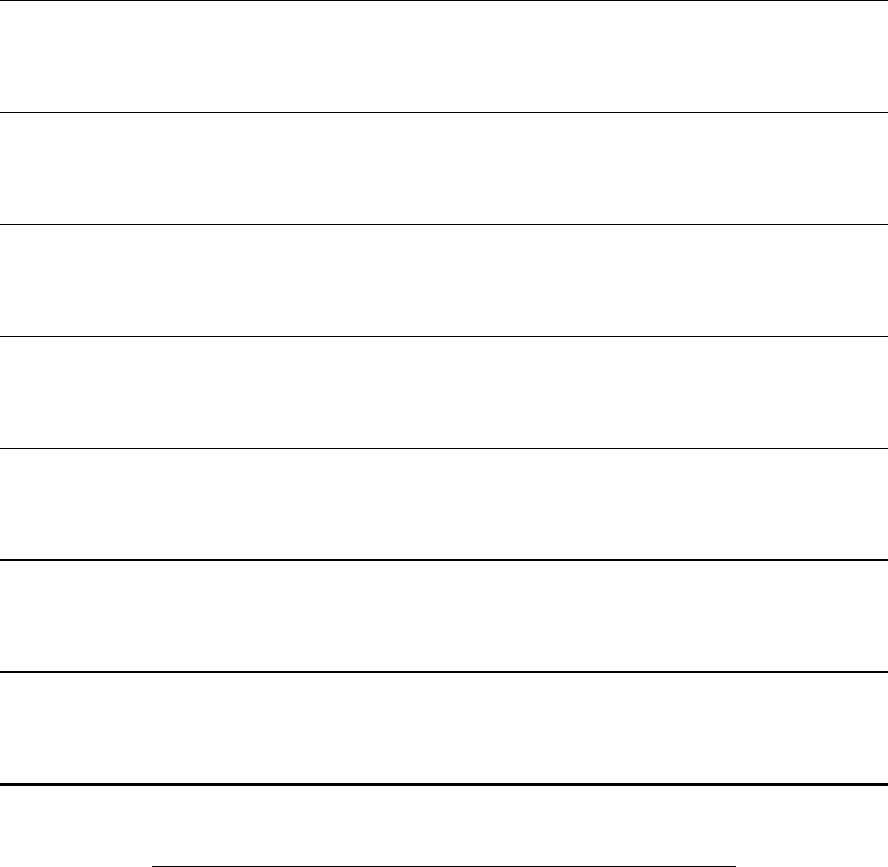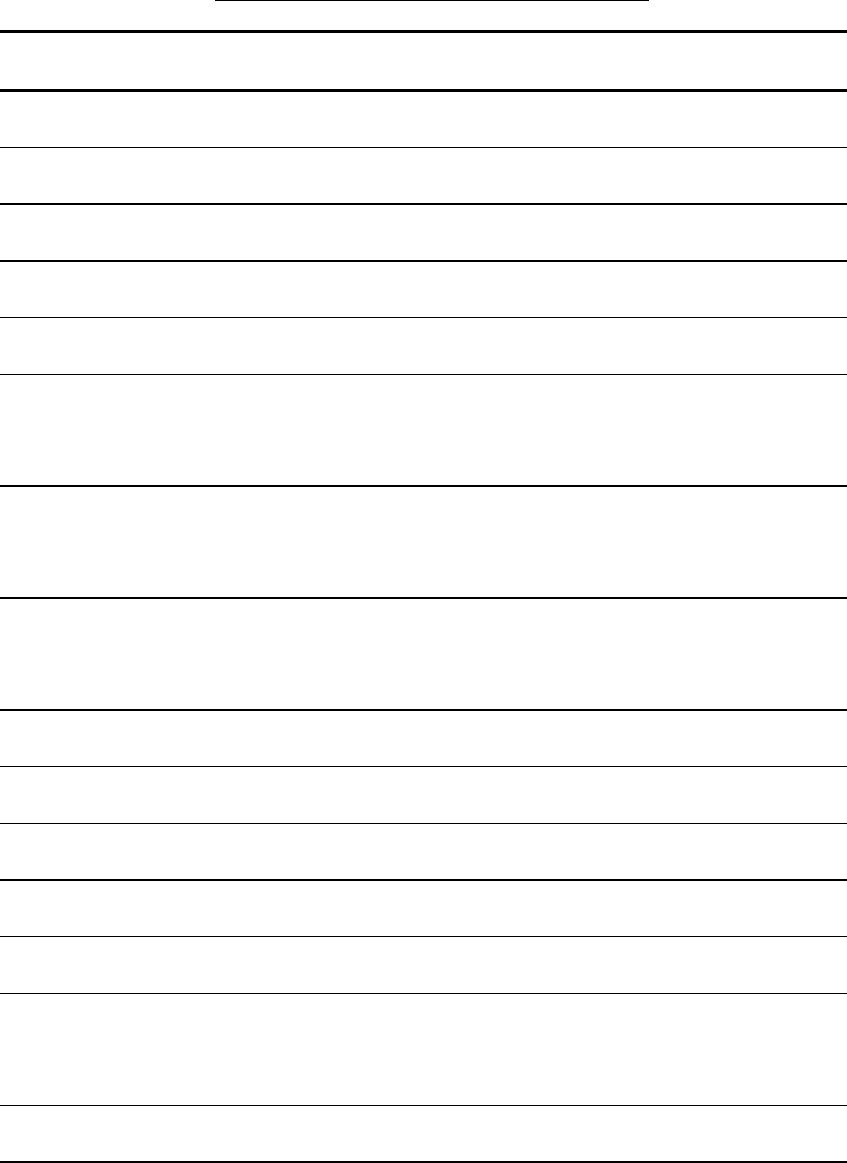NEEDS ASSESSMENT FOR ADMINISTRATIVE OFFICE MANAGER
ASSOCIATE DEGREE PROGRAM
IN THE WESTERN WISCONSIN TECHNICAL COLLEGE DISTRICT
by
James Murray, Jr.
A Research Paper
Submitted in Partial Fulfillment of the
Requirements for the
Master of Science Degree in
Training and Development
Approved for Completion of 4 Semester Credits
TRHRD-735 Field Problem in Training and Development
___________________________________________
Dr. Julie Furst-Bowe, Research Advisor
The Graduate College
University of Wisconsin – Stout
December, 2001

The Graduate College
University of Wisconsin – Stout
Menomonie, WI 54751
ABSTRACT
Murray James, Jr. R.
(Writer) (Last Name) (First) (Initial)
Needs Assessment For Administrative Office Manager Associate Degree Program In The
Western Wisconsin Technical College District
(Title)
Training and Development Dr. Julie Furst-Bowe December, 2001 113
(Graduate Major) (Research Advisor) (Month/Year) (No. of Pages)
American Psychological Association (APA) Publication Manual
(Name of Style Manual Used in this Study)
The changing role of the administrative office manager is creating opportunities
for individuals in the office occupations with the necessary knowledge, skills and
abilities. In Western Wisconsin, two office management occupations, administrative
support supervisors and administrative services managers, are expected to have a growth
rate of 14.8% and 12%, respectively, between 1998 and 2008. Currently, there is not an
associate degree program in the Western Wisconsin Technical College (WWTC ) district,
or the state of Wisconsin, to train administrative office managers.
A needs assessment was undertaken to determine if there is a need for an
associate degree program for administrative office manager in the Western Wisconsin
Technical College district. The needs assessment surveyed a stratified sample of
employers from the WWTC district. Five business program advisory committees were
selected for the survey. The advisory committees consisted of sixty-two members,
representing forty-three business. To ensure the survey reached the employment
ii
specialist, a telephone call was made to each advisory committee member to obtain the
name of the employment specialist. To avoid the employment specialist receiving
duplicate surveys, businesses participating in multiple advisory committees received only
one survey document.
The needs assessment survey was developed to be used in preparation of a
Program Investigation for new programs in the Wisconsin Technical College System.
The Program Investigation includes a needs assessment as a requirement for development
of new programs. If a need exists for a new program in the WWTC District, the Program
Investigation is prepared and submitted the WWTC District Board for approval. Upon
approval by the WWTC District Board, the Program Investigation is submitted to the
Wisconsin Technical College System (WTCS) Board for final approval. No new
programs can be implemented within the state without approval of the WTCS Board.

iii
Table of Contents
Abstract ………….…………………………………………………………………..… i
Table of Contents ……………………………………………………………………… iii
List of Tables ………………………………………………………………………….. vi
Chapter 1, Introduction ………………………………………………………………… 1
The Changing Office …………………………………………………………… 1
Education for Administrative Office Managers ……………………………….. 2
Staffing Challenges for Employers .………………..………………………….. 3
Problem Statement …………………………………………………………….. 4
Research Objectives ……………………………………………………….…... 4
Scope of Needs Assessment …………………………………………………… 4
Significance of Needs Assessment ………………………………………….…. 5
Definition of Terms ……………………………………………………………. 6
Limitations of the Needs Assessment …………………………………………. 8
Chapter 2, Review of Literature ………………………………………………………. 10
Disparity in Administrative Office Manager Titles and Job Descriptions ……. 11
Employment and Wages for Administrative Office Managers …………….…. 16
Job Outlook for Administrative Office Managers ……………………………. 20
Knowledge, Skills, and Abilities for Administrative Office Managers ………. 20
Tasks and Activities for Administrative Office Managers …………………… 25
Educational/Experience Requirements for Administrative Office Managers ... 30
Historical Background of Administrative Office Management Education …… 32
Institutions Offering Administrative Office Manager Programs …………….… 37
iv
WWTC Graduates Hired as Administrative Office Managers………………… 40
Office of the Future …………………………………………………………… 42
Chapter 3, Methodology ………………………………………………………………. 45
Research Design ……………………………………………..………………… 45
Population and Sample ………………………………………………………... 46
Instrumentation …………………………………………………………………. 46
Validation of Survey Document ……………………………………………….. 47
Data Collection ………………………………………………………………… 47
Data Analysis ………………………………………………………………….. 47
Limitations of the Needs Assessment …………………………………………. 48
Chapter 4, Results …………………………………………………………………….. 49
Survey Question 1 …………………………………………………………….. 50
Survey Question 2 ………….……………………………………….………… 50
Survey Question 3 ……………………………………..…………….……….. 53
Survey Question 4 ……………………………..…………………………….. 54
Survey Question 5 ……………..…………………………………………….. 54
Survey Question 6 ……………………………………..…………………….. 55
Survey Question 7 …………………………………………..……………….. 55
Survey Question 8 ………………………..………………………………….. 55
Survey Question 9 …………………………..……………………………….. 56
Survey Question 10 …………………………………..………………………. 56
Survey Question 11 …………………………..………………………………. 56
Survey Question 12 ………………………..…………………………………. 57
v
Survey Question 13 …………………………………………………………… 57
Survey Question 14 …………………………………………………………… 58
Survey Question 15a ………………………………………………………….. 59
Survey Question 15b ………………………………………………………….. 60
Survey Question 15c ………………………………………………………….. 61
Survey Question 15d ………………………………………………………….. 62
Survey Question 15e ………………………………………………………….. 63
Survey Question 15f ………………………………………………………….. 64
Survey Question 15g …………………………………………………………. 65
Survey Question 15h ………………………………………………………….. 66
Survey Question 15i ………………………………………………………….. 67
Survey Question 15j ………………………………………………………….. 68
Survey Question 15k ………………………………………………………….. 69
Survey Question 15l ………………………………………………………….. 70
Survey Question 15m …………………………………………………………. 71
Survey Question 15n ………………………………………………………….. 72
Survey Question 15o ………………………………………………………….. 73
Survey Question 15p ………………………………………………………….. 74
Survey Question 15q ………………………………………………………….. 75
Survey Question 15r ………………………………………………………….. 76
Survey Question 15s ………………………………………………………….. 77
Survey Question 15t ………………………………………………………….. 78
Survey Question 16 …………………………………………………………… 81
vi
Chapter 5, Summary, Conclusion, and Recommendations …………………………… 82
Summary ……………………………………………………………………… 82
Restatement of Problem ………………………………………………. 82
Research Design ………………………………………………………. 82
Population and Sample ………………………………………………... 83
Instrumentation …………………………………….………………….. 83
Data Collection ……………….……………………………………….. 83
Survey Response Rate ……………………..…………………………. 84
Conclusion ……………………………………………………………………. 84
Recommendations for Future Study ………………………………………….. 88
References ………………………………………………………………….…………. 90
Appendix A, WWTC Program Interest Survey Results ……………………….………. 99
Appendix B, Survey Introduction Letter …………………………………………….. 104
Appendix C, Cover Letter for Survey ……………………………………………….. 105
Appendix D, Needs Assessment Survey ……………….……………………………. 106
Appendix E, Follow-Up Letter for Non-Respondents …………………….…………. 110
Appendix F, Survey Comments ……………………………………………………… 111

vii
List of Tables
Chapter 2
Table 1, 1999 Occupational Employment and Wage Estimates for
Administrative Office Managers …………………….…………………….. 17
Table 2, Western Wisconsin Workforce Development Areas 1998
Occupational Wage Employment Estimates for Administrative
Office Managers ……………………..…………………………………….. 18
Table 3, Western Wisconsin Estimated Growth for Administrative
Office Managers 1998-2008 …………………………….………………… 19
Table 4, ACINet’s Knowledge, Skills, and Abilities for Administrative
Service Managers and First-Line Supervisors of Administrative
Support Workers ………………………………….…………….…………. 21
Table 5, ACINet’s Tasks and Activities for Administrative Office
Managers ………………………………………………..…………………. 26
Table 6, ACINet’s Education and Training for Administrative
Office Managers …………………………………………………..……….. 31
Table 7, Institutions Offering Programs in Administrative Office
Management …………………………………..…………………………… 38
Table 8, WWTC Graduates Hired as Office Managers ……….……………… 41
Chapter 4
Table 9, Qualifications of an Administrative Office Manager Based
On the Needs Assessment Mean …………………………………….…….. 79
viii
Chapter 5
Table 10, Encouraging Continuing Education for Administrative Office
Manager by Company Size …………………………………..…………… 85
Table 11, Growth by Company for Administrative Office Managers ..…….… 86
Table 12, Should Western Wisconsin Technical College Offer an
Administrative Office Manager Program by Company Size ………….…… 87
Appendix A
Table 13, WWTC Program Interest Survey Results ………….………..…..….. 99

Chapter 1
Introduction
The role of the administrative office manager is changing. To address this issue,
this first chapter will review the changing office, education for administrative office
managers, staffing challenges for employers, the problem statement, research objectives,
scope of the needs assessment, significance of the needs assessment, definition of terms,
and the limitations of the needs assessment.
The Changing Office
A revolution is taking place in offices. This revolution is transforming many of
the fundamental ways organizations do business. The success of an organization, now
more than ever, is focused upon the ability to manage. “Managing people is crucial to the
success of any organization” (Belker, 1997, 4). Historically it has been the administrative
office manager’s responsibility to manage the office personnel as well as the
organization’s office functions. But in the changing business environment, the
administrative office manager has begun to have an impact upon the entire organization.
With the advent of increased office technology, the administrative office manager must
also manage information for the organization. Today, the administrative office manager
interacts with all components of the organization by providing needed information, when
needed, and in a useable format (Quible, 2001).
Due to the increased utilization of office technology and the interaction with the
whole organization, the role of the administrative office manager is rapidly evolving.
The administrative office manager must not only be savvy in office functions, personnel
management, and information management, but also in such realms as technology

2
changes, systems design and analysis, problem-solving, cost management, budgeting,
diversity in the workplace, and business globalization. The role of the administrative
office manager has “expanded tremendously, often without additional training” (Gadener
& Lea, 2000, 7).
Education for Administrative Office Managers
The evolving role of the administrative office manager requires a diverse
educational background. Individuals entering the market, as well as current
administrative office managers, must utilize management skills such as planning,
organizing, staffing, directing, and controlling (Quible, 2001).
In addition, administrative office managers are going to be required to possess
skills in facilitating, managing resources, innovating, evaluating and implementing
emerging technologies, and solving complex problems (Gadener & Lea, 2000). The
administrative office manager will also be required to serve as a change agent, decipher
complex government regulations, analyze organizational productivity, make system(s)
modifications, accommodate diversity into the workplace, and ensure that the
organization is able to function globally (Quible, 2001).
Administrative office management is considered as a supportive function within
an organization. Therefore, the administrative office manager should have a solid
background in accounting, marketing, management, statistics, economics, and
psychology. Other skills include: interpersonal behavior and human relation skills; ethical
behavior; ability to delegate responsibility; and accept the viewpoint of others. The
administrative office manager must have the initiative and desire to continue to learn and

3
develop professionally (Quible, 2001). Furthermore, strong communication and soft skills
such as business acumen and leadership ability are required (Domeyer, 2000).
Staffing Challenges for Employers
The United States Department of Labor Occupational Handbook, 2000-2001
Edition, indicates there are over 10 million office professionals. Of these professionals,
almost 2.5 million are in some management position with 1.6 million being classified as
office and administrative support managers and 894,000 being classified as
administrative service managers. Economists in the Labor Bureau’s Office of
Employment Projections predict between 1-2 million new office professional positions
will be created between 1998-2008. There is a serious shortage of qualified workers to
fill these positions (Gadener & Lea, 2000).
According to William Brockmiller, Labor Market Analyst, Western Region
Division of Workforce Excellence, State of Wisconsin Department of Workforce
Development, the occupation of administrative support supervisors, Occupational
Employment Statistic (OES) code 51002, indicates a growth of 14.8% from 1998-2008 in
the WWTC district. In the occupational title, administrative services managers, OES code
13014, a growth rate of 12% is indicated, during the same period, within the WWTC
district (State of Wisconsin, Department of Workforce Development, 2001, Master WDA
List).
In four business program advisory committee meetings (accounting, office
technology, human resource—business administration, and finance), 78.3% of the
employers indicated interest in an associate degree program for administrative office
manager. The percentage was derived from a program interest survey, Appendix A,

4
conducted during the spring 2001 advisory committee meetings. Currently, there is not an
associate degree program in the WWTC district, or the state of Wisconsin, to train
administrative office managers.
Problem Statement
Is there a need for an associate degree program for administrative office manager
in the Western Wisconsin Technical College district?
Research Objectives
The primary purpose of this research is to conduct a needs assessment to
determine if there is a need for an administrative office manager associate degree
program in the WWTC district. If there is a need, the needs assessment will be presented
to the vice-president of instruction for WWTC to determine if a Program Investigation
needs to be prepared for submission to the WWTC district board. A needs assessment is
required as part of the Program Investigation. Upon approval by the WWTC district
board, the Program Investigation for the administrative office manager program is
submitted to the Wisconsin Technical College Board (WTCB), or state board, for
program approval. Each technical college program must have the approval of the WTCB
prior to implementing a program.
Scope of Needs Assessment
The population to be surveyed will be within the WWTC district. Within that
population, a stratified sample will be drawn. The sample will include employers from
five of WWTC’s program advisory committees. The programs include: accounting,
office technology, human resource—business administration, finance, and paralegal.

5
Significance of Needs Assessment
1. There is significant growth in the administrative office manager occupation in
the WWTC district during the period 1998-2008. Employers have indicated an
interest for WWTC to provide the education necessary for these professionals.
2. A needs assessment is required for preparation of the Program Investigation to
be submitted to the Wisconsin Technical College Board for approval of an
associate degree program in the WWTC district.
3. There are dynamic changes occurring in the office occupations. Employers
within the WWTC district need administrative office managers who are
educated and can implement these changes within the employer’s
organization.
4. The role of administrative office manager is rapidly evolving. Current
administrative office managers in the WWTC district are going to need
continuing education to maintain and improve their knowledge and skills.
5. With the maturing workforce, turnover (separation) in the administrative
office manager profession may leave employers without trained professionals
in the WWTC district.
Definition of Terms
Administrative office manager
is a generic job title. The title combines two of the
most frequently used titles for governmental reporting purposes: administrative services
managers and first-line supervisors of administrative support workers). The definition
combines the occupational specific tasks and generalized work activities for these two
occupations. For the needs assessment the definition will be:

6
Coordinates activities of clerical personnel in establishment or organization:
Analyses and organizes office operations and procedures, such as typing,
bookkeeping, preparation of payrolls, flow of correspondence, filing, requisition
of supplies, and other clerical services. Evaluates office production, revises
procedures, or devises new forms to improve efficiency of workflow. Establishes
uniform correspondence procedures and style practices. Formulates procedures
for systematic retention, protection, retrieval, transfer, and disposal of records.
Plans office layouts and initiates cost reduction programs. Reviews clerical and
personnel records to ensure completeness, accuracy, and timeliness. Prepares
activities reports for guidance of management, using computer. Prepares
employee ratings and conducts employee benefit and insurance programs, using
computer. Coordinates activities of various clerical departments or workers within
department. May prepare organizational budget and monthly financial reports.
May hire, train, and supervise clerical staff. May compile, store, and retrieve
managerial data, using computer (United States Department of Labor Office of
Administrative Law Judges Law Library, 1991, §169.167-034).
Each program in the WWTC district has an advisory committee
established by the
district board. Each advisory committee consists of equal numbers of employers and
employees selected by the district board from recommendations submitted by
representative organizations and associations of each occupation. The district board and
the district director may request the advice and assistance of these advisory committees in
selecting, purchasing, and installing equipment; in preparing course materials; in

7
developing instructional methods and vocational guidance programs; and for such other
purposes as the district board desires (Wisconsin Legislature, 2001, §38.14.5).
An associate degree program
is a 2-year, post-high school program in an area
designated and approved by the state board for which the course requirements are
established by the state board (Wisconsin Legislature, 2001, §38.01.1).
A technical college district
includes one or more counties, municipalities, or
school districts in any contiguous combination (Wisconsin Legislature, 2001, §38.06.1).
Wisconsin has 16 technical college districts (Chin, 1999). Western Wisconsin Technical
College is composed of eleven counties and operates six campuses (Western Wisconsin
Technical College [WWTC], 1999).
The district board
for a technical college is in charge of the technical colleges of a
district (Wisconsin Legislature, 2001, §38.01.6). The district board should maintain
courses at standards acceptable to national, regional, and professional accrediting
agencies and associations (Wisconsin Legislature, 2001, §38.001.2.a).
A district director
is responsible for the general supervision and management of
the development and work of the district schools (Wisconsin Legislature, 2001,
§38.12.3.1).
A program
is a state-approved group or cluster of courses leading to a vocational
diploma or an associate degree. Programs are defined by a unique title and approved
curriculum (Course and Program Curriculum Approval User Guide, 2001, Section 9).
The state board
, also known as the Wisconsin Technical College System Board, is
the governing agency for statewide policy and fiscal issues related to the 16 Wisconsin
technical colleges (Course and Program Curriculum Approval User Guide, 2001,

8
Section 9).
A technical college, in Wisconsin, provides education through associate degree
programs and other programs below the baccalaureate level (Wisconsin Legislature,
2001, §38.001). The principal purposes of a technical college are to provide occupational
education and training and retraining programs, including training of apprentices, that
enable residents to obtain knowledge and skills necessary for employment at a technical,
paraprofessional, skilled or semiskilled occupation (Wisconsin Legislature, §38.001.2.a).
A technical college also provides customized training and technical assistance to business
and industry in order to foster economic development and expansion of employment
opportunities (Wisconsin Legislature, §38.001.2.b).
A vocational diploma
program is a one- or two-year, full-time program in an area
designated and approved by the state board for which the course requirements are
established by the state board (Wisconsin Legislature, 2001, §38.01.11).
Limitations of the Needs Assessment
1. Relative to the entire employer population within the WWTC district,
employers serving on program advisory committees are a relatively small
percentage. The stratified sampling is thus rather limited.
2. The occupational title “administrative office manager” is a generic title. Each
company defines job titles and job responsibilities in different ways. One
office may have an administrative assistant do entry-level work, while in
another company, s/he may manage an entire office (Gadener & Lea, 2000,
October). Therefore, the working definition of administrative office manager
9
may not coordinate with job titles or job responsibilities of employers within
the WWTC district.

Chapter 2
Review of Literature
There is a revolution occurring in the way organizations do business. The
revolution is having a direct impact on the role of the administrative office manager. The
administrative office manager’s role is evolving into a key component in the business
organization. In today’s business climate, the administrative office manager not only
manages office personnel and functions, as in the past, but must also must be skilled in
facilitating, solving complex problems, interpersonal behavior and human relation skills,
ethical behavior, diversity, leadership, and business globalization.
The changing role of the administrative office manager is creating opportunities
for individuals in the office occupations with the necessary knowledge, skills and
abilities. In Western Wisconsin, two office management occupations, administrative
support supervisors and administrative services managers, are expected to have a growth
rate of 14.8% and 12%, respectively, between 1998 and 2008 (State of Wisconsin,
Department of Workforce Development, 2001, Master WDA List). Currently, there is not
an associate degree program in the WWTC district, or the state of Wisconsin, to train
administrative office managers.
The purpose of this literature review is to take a look at the administrative office
manager occupation. The review will include the following topics for administrative
office managers: disparity in titles and job descriptions; employment and wages; the job
outlook; knowledge, skills and abilities; tasks and activities; educational/experience
requirements; a historical review of administrative office management education;

11
institutions offering administrative office management programs; WWTC graduates hired
as administrative office managers; and the office of the future.
Disparity in Administrative Office Manager Titles and Job Descriptions
The office professional field has come to represent a wide variety of occupations.
There is no consistency between companies as far as job titles and responsibilities. West
Valley College Office Administration Advisory Board, Saratoga, CA, studied the
changing role of the secretary. In the study, the Board was able to separate office jobs
into three categories with specific job titles falling under each of the categories. Even
with a specific job title, duties varied from business to business. The categories and titles
are:
- General Office Jobs: data entry clerk, word processor, office assistant,
receptionist, and secretary
- Specialized Office Jobs: accounting assistant, customer service
representative, desktop publisher, human resources specialist, marketing
assistant, and meeting and event planner
- Administrative Management Jobs: administrative assistant, executive
assistant, office manager, and administrative services (Gadener & Lea,
2000).
The Dictionary of Occupational Titles (DOT), created by the U. S. Department of
Labor, is a standard reference for cases adjudicated by the Office of Administrative Law
Judges, especially labor-related immigration cases (Office of Administrative Law
Library, 1991). This needs assessment’s working definition of administrative office
manager is taken from the DOT. The DOT job title is office manager (any industry),
12
DOT code 169.167-034. Alternative titles for the same job title include: chief clerk and
administrative services manager (United States Department of Labor Office of
Administrative Law Judges Law Library, 1991, §169.167-034).
The DOT is being replaced by the Employment and Training Administration’s
O*Net. O*Net, the Occupational Information Network, contains comprehensive
information on job requirements and worker competencies (Employment & Training
Administration, 1). O*Net uses a broader categorization than DOT; therefore, several
occupations listed in the DOT will appear under one O*Net occupational title. A search
for the occupational title “office manager” in the O*Net database produced no results.
The O*Net occupational title that includes management in office occupations is
administrative services managers.
The O*Net brief job description for administrative services mangers, code
11-3011.00, is: “plan, direct, or coordinate supportive services of an organization, such as
recordkeeping, mail distribution, telephone operator/receptionist, and other office support
services. May oversee facilities planning and maintenance and custodial operations”
(O*Net, Administrative Services Managers). DOT occupational titles included under this
O*Net classification are: office manager, radiology administer, court administrator,
service director, property-disposal officer, and unclaimed property officer. (O*Net,
Administrative Services Managers).
A more detailed task list of O*Net’s occupation of administrative services
managers is:
Coordinates activities of clerical and administrative personnel in establishment or
organization. Analyzes and organizes office operations, procedures, and
13
production to improve efficiency. Recommends cost-saving methods, such as
supply changes and disposal of records to improve efficiency of department.
Prepares and reviews reports and schedules to ensure accuracy and efficiency.
Formulates budgetary reports. Hires and terminates clerical and administrative
personnel. Conducts classes to teach procedures to staff (Farr & Ludden, 1998,
9-10).
The Bureau of Labor Statistics (BLS) is another government reporting agency.
The BLS established the Standard Occupational Classification (SOC) system “used by all
Federal statistical agencies to classify workers into occupational categories for the
purpose of collecting, calculating, or disseminating data” (Bureau of Labor Statistics,
2001, 1). The BLS uses the same occupational title and description as O*Net,
administrative services managers. The SOC code for administrative services managers is
11-3011. There is no listing for office managers in the BLS occupational titles.
Another classification used by both O*Net and SOC is first-line supervisors,
administrative support. The O*Net code is 43-1011.02 and the SOC code is 43-1011.
O*Net’s brief description and task list for this occupational classification is:
Supervise and coordinate activities of workers involved in providing
administrative support. Supervises and coordinates activities of workers engaged
in clerical, administrative support, or service activities. Directs workers in such
activities as maintaining files, compiling and preparing reports, computing
figures, or moving shipments. Plans, prepares, and revises work schedules and
duty assignments according to budget allotments, customer needs, problems,
workloads, and statistical forecasts. Evaluates subordinate job performance and
14
conformance to regulations, and recommends appropriate personnel action.
Oversees, coordinates, or performs activities associated with shipping, receiving,
distribution, and transportation. Verifies completeness and accuracy of
subordinates’ work, computations, and records. Interviews, selects, and
discharges employees. Consults with supervisor and other personnel to resolve
problems, such as equipment performance, output quality, and work schedules.
Reviews records and reports pertaining to such activities as production, operation,
payroll, customer accounts, and shipping. Trains employees in work and safety
procedures and company policies. Participates in work of subordinates to
facilitate productivity or overcome difficult aspects of work. Examines procedures
and recommends changes to save time, labor, and other costs and to improve
quality control and operating efficiency. Maintains records of such matters as
inventory, personnel, orders, supplies, and machine maintenance. Identifies and
resolves discrepancies or errors. Compiles reports and information required by
management or governmental agencies. Plans layout of stockroom, warehouse, or
other storage areas, considering turnover, size, weight, and related factors
pertaining to items stored. Inspects equipment for defects and notifies
maintenance personnel or outside service contractors for repairs. Analyzes
financial activities of establishment or department and assists in planning budget.
Computes figures, such as balances, totals, and commissions. Requisitions
supplies (Farr & Ludden, 1998, 215-6).

15
One explanation as to the different titles for administrative service managers and
first-line supervisors of administrative support workers appears in the Bureau of Labor
Statistics’
Occupational Outlook Handbook
. The Handbook states:
In small organizations, a single administrative services manager may oversee all
support services. In larger one, however, first-line administrative services
managers often report to mid-level managers who in turn, report to owners or top-
level managers. As the size of the firm increases, administrative services
managers are more likely to specialize in specific support activities. For example,
some administrative services managers work primarily as office managers,
contract administrators, or unclaimed property managers (Bureau of Labor
Statistics, 2000, July17, 2).
Although the basic job descriptions are the same for administrative services
managers, there is difficulty in an exact occupational job title and occupational
description for administrative office manager. The Department of Labor’s DOT provides
a concise job description while the Employment and Training Administration’s O*Net
and the Bureau of Labor Statistics’ SOC job description is very broad. The first-line
supervisors, administrative support occupation duplicates some of the duties of
administrative service managers. This duplication of duties can cause confusion in
reporting information to governmental agencies if there is not a matching job title within
the reporting firm. All three of the occupational codes (DOT, O*Net, and SOC) are used
by various federal and state agencies for reporting occupational data. The federal and
state agencies will use only one of the occupational codes when collecting data.

16
OfficeTeam, is the world’s leading staffing service specializing in highly skilled
temporary office and administrative professionals. OfficeTeam has more than 200
locations worldwide as well as offering online job services. OfficeTeam does not use the
federal occupational titles in its publications. Instead, the firm uses the titles office
manager and senior office manager.
OfficeTeam’s job description for an office manager is: “Coordinates various
office support services, including purchasing and facilities management. Requires strong
communication skills with vendors and some accounting knowledge. May include
supervision of office administrative staff “ (OfficeTeam, 2001, 20). OfficeTeam’s job
description for senior office manager is:
Responsibilities include those described for office manager but with more
extensive experience in management skills. Duties may include selecting office
vendors and supervising purchasing processes, directing mailroom and
maintenance staff, and coordinating regular building safety checks and
ergonomics training for staff. Solid communication and staff management skills
are required, as well as some accounting knowledge (OfficeTeam, 2001, 20).
There is quite a disparity in job titles and descriptions for the administrative office
manager occupation. Titles and job descriptions for the occupation vary from business to
business as well as from governmental agency to governmental agency.
Employment and Wages for Administrative Office Managers
Employment and wage projections are provided by many federal and state
agencies. Include in Table 1 are the Occupational Employment Statistics for 1999, from

17
the BLS, for the occupations administrative service managers and first-line supervisors of
administrative support workers.
Table 1
1999 Occupational Employment and Wage Estimates for
Administrative Office Managers
Occupational Title Location Employment Estimated
Median
Hourly
Estimated
Mean
Hourly
Estimated
Mean
Annual
Administrative
Services Managers
Federal 363,530 $20.78 $23.36 $48,580
Wisconsin 7,370 $19.33 $21.68 $45,090
La Crosse none listed none
listed
none
listed
none
listed
First-line
Supervisors—
Administrative
Support Workers
Federal 1,312,630
$15.93 $17.36 $36,110
Wisconsin 21,340 $15.07 $16.17 $33,630
La Crosse 390 $14.97 $16.13 $33,540
Note.
From (Bureau of Labor Statistics, 2001)

18
The U. S. Department of Labor and Wisconsin Department of Workforce
Development provides occupational information for administrative service managers and
first-line supervisors of administrative support workers. Information for 1998
occupational wages for each occupation, from the Office of Employment Statistics
(information is from census figures) is included in Table 2.
Table 2
Western Wisconsin Workforce Development Areas 1998 Occupational Wage
Employment Estimates for Administrative Office Managers
Occupational Title Job
Count
Estimated
Hourly
Wage
Mean
Estimated
Hourly
Wage
Median
Estimated
Hourly
Wage
Low
Estimated
Hourly
Wage
High
Administrative Services
Managers
310 $14.09 $10.94 $6.19 $20.47
First Line Supervisors—
Administrative Support
Workers
910 $15.26 $14.26 $10.53 $18.35
Note.
From (Wisconsin Department of Workforce Development, 2001)
The growth rate for administrative service managers and first-line supervisors of
administrative support workers in Western Wisconsin from 1998-2008 is included in
Table 3. The Western Wisconsin Workforce Development Area synthesized the
information from information-collected through
Wisconsin Projections, 1998-2008
.

19
Table 3
Western Wisconsin Estimated Growth for Administrative Office Managers 1998-2008
Occupational Title 1998-2008
Growth
%
Change
Estimated
Average
Annual
Openings:
Growth
Estimated
Average
Annual
Openings:
Separations
Estimated
Average
Annual
Openings:
Total
Administrative
Services Managers 30 12.0% 3 4 7
First Line
Supervisors—
Administrative
Support Workers
170 14.8% 17 26 43
Note. From (Wisconsin Department of Workforce Development, 2001)
Job Outlook for Administrative Office Managers
Employment for both administrative services managers and for first-line
supervisors of administrative support workers is expected to grow about as fast as the
average for all occupations through 2008 (Bureau of Labor Statistics, 2000, July 17) and
(Bureau of Labor Statistics, 2000, July 30). The term, “as fast as the average,” indicates
an increase of 10 to 20 percent (Bureau of Labor Statistics, 2000, April 19).
The BLS indicates that job opportunities for jobs in both occupations may face
keen competition because the number of applicants seeking jobs (Bureau of Labor

20
Statistics, 2000, July 17) and (Bureau of Labor Statistics, 2000, July 30). The BLS does
indicate that the administrative services manager occupation may have many additional
job openings from the need to replace workers who transfer to other jobs, retire, or stop
working for other reasons (Bureau of Labor Statistics, 2000, July 17). Employment of
first-line supervisors of administrative support workers is primarily affected by the
demand for clerical workers. Some clerical occupations may decline because of
automation. However, first-line supervisors of administrative support workers will be
needed to coordinate the increasing amount of clerical work and make sure technology is
applied and running smoothly. Also, organizational restructuring continues to reduce
some middle management positions, distributing more responsibility to first-line
supervisors of administrative support workers. This added responsibility combined with
relatively higher skills will most likely place first-line supervisors of administrative
support workers among clerical workers most likely to retain their jobs (Bureau of Labor
Statistics, 2000, July 30).
Knowledge, Skills, and Abilities for Administrative Office Managers
America’s Career InfoNet (ACINet), summaries occupational information from
O*Net. ACINet was sponsored by the Department of Labor as one component to provide
information on today’s labor market for the job seeker, employer, and the training and
education community (America's Career InfoNet, About Us). ACINet’s includes the
major knowledge, skills, and abilities, with descriptions, for occupations included in the
O*Net database. The knowledge, skills, and abilities, listed in order of importance, for
administrative service managers and first-line supervisors of administrative support
workers are included in Table 4.

21
Table 4
ACINet’s Knowledge, Skills, and Abilities for Administrative Service Managers and
First-Line Supervisors of Administrative Support Workers
Administrative Services Managers First-line Supervisors—
Administrative Support Workers
Knowledge Administration and Management—
Knowledge of principles and
processes involved in business and
organizational planning,
coordination, and execution. This
includes strategic planning, resource
allocation, manpower modeling,
leadership techniques, and
production methods.
Administration and Management—
Knowledge of principles and
processes involved in business and
organizational planning,
coordination, and execution. This
includes strategic planning,
resource allocation, manpower
modeling, leadership techniques,
and production methods.
Economics and Accounting—
Knowledge of economic and
accounting principles and practices,
the financial markets, banking, and
the analysis and reporting of
financial data.
Clerical—Knowledge
of administrative and clerical
procedures and systems such as
word processing systems, filing and
records management systems,
stenography and transcription,
forms design principles, and other
office procedures and terminology.

22
English Language—Knowledge of
the structure and content of the
English language including the
meaning and spelling of words, rules
of composition, and grammar.
English Language—Knowledge
of the structure and content of the
English language including the
meaning and spelling of words,
rules of composition, and grammar.
Personnel and Human Resources—
Knowledge of policies and practices
involved in personnel/human
resource functions. This includes
recruitment, selection, training, and
promotion regulations and
procedures; compensation and
benefits packages; labor relations
and negotiation strategies; and
personnel information systems.
Mathematics—Knowledge of
numbers, their operations, and
interrelationships including
arithmetic, algebra, geometry,
calculus, statistics, and their
applications.

23
Clerical—Knowledge of
administrative and clerical
procedures and systems such as
word processing systems, filing and
records management systems,
stenography and transcription, forms
design principles, and other office
procedures and terminology.
Personnel and Human Resources—
Knowledge of policies and
practices involved in
personnel/human resource
functions. This includes
recruitment, selection, training, and
promotion regulations and
procedures; compensation and
benefits packages; labor relations
and negotiation strategies; and
personnel information systems.
Skills Coordination—Adjusting actions in
relation to others' actions.
Management of Personnel
Resources—Motivating,
developing, and directing people as
they work, identifying the best
people for the job.
Writing—Communicating
effectively with others in writing as
indicated by the needs of the
audience.
Speaking—Talking to others to
effectively convey information.
Judgment and Decision Making—
Weighing the relative costs and
benefits of a potential action.
Time Management—Managing
one's own time and the time of
others.

24
Management of Personnel
Resources—Motivating, developing,
and directing people as they work,
identifying the best people for the
job.
Monitoring—Assessing how well
one is doing when learning or doing
something.
Reading Comprehension—
Understanding written sentences and
paragraphs in work related
documents.
Reading Comprehension—
Understanding written sentences
and paragraphs in work related
documents.
Abilities Oral Expression—The ability to
communicate information and ideas
in speaking so others will
understand.
Oral Expression—The ability to
communicate information and ideas
in speaking so others will
understand.
Oral Comprehension—The ability to
listen to and understand information
and ideas presented through spoken
words and sentences.
Oral Comprehension—The ability
to listen to and understand
information and ideas presented
through spoken words and
sentences.
Speech Clarity—The ability to speak
clearly so that it is understandable to
a listener.
Written Expression—The ability to
communicate information and ideas
in writing so others will understand.

25
Written Comprehension—The
ability to read and understand
information and ideas presented in
writing.
Written Comprehension—The
ability to read and understand
information and ideas presented in
writing.
Written Expression—The ability to
communicate information and ideas
in writing so others will understand.
Near Vision—The ability to see
details of objects at a close range
(within a few feet of the observer).
Speech Clarity—The ability to
speak clearly so that it is
understandable to a listener.
Note. From (America's Career InfoNet, Administrative Services Managers) and
(America's Career InfoNet, First-Line Supervisors of Administrative Support Workers)
Tasks and Activities for Administrative Office Managers
The occupational specific tasks and activities are also included in ACINet. The
specific tasks and activities for administrative service managers and first-line supervisors
of administrative support workers are included in Table 5.

26
Table 5
ACINet’s Tasks and Activities for Administrative Office Managers
Administrative Services
Managers
First-line Supervisors—
Administrative Support Workers
Occupational
Specific
Tasks
Coordinates activities of clerical
and administrative personnel in
establishment or organization.
Supervises and coordinates activities
of workers engaged in clerical or
administrative support activities.
Analyzes internal processes and
plans or implements procedural
and policy changes to improve
operations.
Plans, prepares, and revises work
schedules and duty assignments
according to budget allotments,
customer needs, problems, work-
loads, and statistical forecasts.
Recommends cost saving
methods, such as supply changes
and disposal of records to
improve efficiency of
department.
Evaluates subordinate job
performance and conformance to
regulations, and recommends
appropriate personnel action.
Prepares and reviews operational
reports and schedules to ensure
accuracy and efficiency.
Oversees, coordinates, or performs
activities associated with shipping,
receiving, distribution, and
transportation.

27
Formulates budgetary reports. Verifies completeness and accuracy
of subordinates' work, computations,
and records.
Hires and terminates clerical and
administrative personnel.
Interviews, selects, and discharges
employees.
Conducts classes to teach
procedures to staff.
Consults with supervisor and other
personnel to resolve problems, such
as equipment performance, output
quality, and work schedules.
Reviews records and reports
pertaining to such activities as
production, operation, pay roll,
customer accounts, and shipping.
Trains employees in work and safety
procedures and company policies.
Participates in work of subordinates
to facilitate productivity or overcome
difficult aspects of work.
Examines procedures and
recommends changes to save time,
labor, and other costs and to improve
quality control and operating
efficiency.

28
Maintains records of such matters as
inventory, personnel, orders,
supplies, and machine maintenance.
Identifies and resolves discrepancies
or errors.
Compiles reports and information
required by management or
governmental agencies.
Plans layout of stockroom,
warehouse, or other storage areas,
considering turnover, size, weight,
and related factors pertaining to items
stored.
Inspects equipment for defects and
notifies maintenance personnel or
outside service contractors for
repairs.
Analyzes financial activities of
establishment or department and
assists in planning budget.
Computes figures, such as balances,
totals, and commissions.
Requisitions supplies.

29
Generalized
Work
Activities
Communicating With Other
Workers--Providing information
to supervisors, fellow workers,
and subordinates. This
information can be exchanged
face-to-face, in writing, or via
telephone/electronic transfer.
Coordinating Work & Activities of
Others--Coordinating members of a
work group to accomplish tasks.
Getting Information Needed to
Do the Job--Observing,
receiving, and otherwise
obtaining information from all
relevant sources.
Guiding, Directing & Motivating
Subordinates--Providing guidance
and direction to subordinates,
including setting performance
standards and monitoring
subordinates.
Staffing Organizational Units--
Recruiting, interviewing,
selecting, hiring, and promoting
persons for the organization
Coaching and Developing Others--
Identifying developmental needs of
others and coaching or otherwise
helping others to improve their
knowledge or skills.
Analyzing Data or Information--
Identifying underlying principles,
reasons, or facts by breaking
down information or data into
separate parts.
Establishing & Maintaining
Relationships--Developing
constructive and cooperative working
relationships with others.

30
Coordinating Work & Activities
of Others--Coordinating members
of a work group to accomplish
tasks.
Getting Information Needed to Do
the Job--Observing, receiving, and
otherwise obtaining information from
all relevant sources.
Performing Administrative
Activities - Approving requests,
handling paperwork, and
performing day-to-day
administrative tasks.
Performing Administrative Activities
- Approving requests, handling
paperwork, and performing day-to-
day administrative tasks.
Provide Consultation & Advice
to Others--Providing consultation
and expert advice to management
or other groups on technical,
systems-related, or process
related topics.
Note. From (America's Career InfoNet, Administrative Services Managers) and
(America's Career InfoNet, First-Line Supervisors of Administrative Support Workers)
Educational/Experience Requirements for Administrative Office Managers
The education requirements for administrative office managers vary from
business to business. ACINet’s education and training requirements are listed in Table 6.

31
Table 6
ACINet’s Education and Training for Administrative Office Managers
Administrative Services
Managers
First-line Supervisors—
Administrative Support Workers
Typical
Educational Level
Work experience plus degree Work experience in related
occupation
Typical Training Business Administration and
Management, General
Office Supervision and
Management
Logistics and Materials
Management
Public Administration
Note. From (America's Career InfoNet, Administrative Services Managers) and
(America's Career InfoNet, First-Line Supervisors of Administrative Support Workers)
The U. S. Department of Labor Office of Administrative Law Judges Law
Library’s Dictionary of Occupational Titles
states in the professional, technical, and
managerial occupations, office manager is listed in this section, that “these occupations
require substantial educational preparation (usually at the university, junior college, or
technical institute level” (United States Department of Labor Office of Administrative
Law Judges Law Library, 1991, 1).
Many administrative services managers are promoted from within the
organization. These managers have demonstrated knowledge and skills that are
important to the employer. Associate degrees or bachelor’s degrees in business

32
administration or related fields are recommended for employment and enhance
advancement opportunities (Wisconsin Careers, 1999, classification 1370.0).
Administrative support supervisors are often promoted from within the organization.
Employers prefer to hire people who have an associate or bachelor’s degree. The degree
program should be in supervision and management (Wisconsin Careers, 1999,
classification 4510.0).
Historical Background of Administrative Office Management Education
In the early 1900’s technological advances introduced a revolution in offices.
Geoffry S. Childs, of the Alexander Hamilton Institute, states, “Appliances add to
complexity, and complexity adds to appliances”(Childs, 1921, 2). Technology
(appliances) has continued to change the way the office operates and functions. In the
past two decades, there has been one revolution after another in all types of business
activity, and nowhere has this revolution been more keenly felt than in the office. Routine
tasks completed manually have been replaced with computers (personal or networked).
Electronic apparatus have replaced the pen and pencil. Documents that use to take days to
reach a second party now only take a few seconds. Introducing and utilizing these
technological advances has added more complexity to office functions. Despite these
technological changes, office administration issues have been relatively unchanged since
the first part of the twentieth century.
Childs writes in the Office Administration
text:
This spirit of the times is more and more finding expression in the conduct of
offices as well as factories. The office manager is a relatively new functionary.
Unconsciously perhaps he is bringing to bear upon the problems of this work
33
those principles which lie at the root of factory management, adapting them as he
proceeds to the special conditions with which he has to deal.
Because he has been concerned with one question of detail after another,
the office manager and the executive over him have been unconscious of the fact
that there was behind these several problems, in embryo, at least, a science of
office management (Childs, 1921, v).
Common themes have continued in the 80+ years since the Alexander Hamilton
Institute published its text. Throughout these years, publications in office administration
have echoed the themes of the modern office, motivating employees, compensation,
productivity, communications, management, paperwork issues, and training. Over the
years, textbooks and handbooks repeatedly emphasize these themes.
Childs’ (1921) text discusses issues such as:
- The Office in Modern Business—magnitude of the modern office; office
workers; practices; principles; and building up the science
- Layout of the Office—size of office; abolishing private offices; work flow;
temperature; lighting systems; and noise prevention
- Office Equipment—standardizing equipment; modern desk; orderly desks;
office supplies; forms; and the stocking and consumption of supplies
- Office Appliances—labor-saving machinery; typewriters; dictating
equipment; printing presses; telephones; adding machines; and photographing
equipment
34
- Selecting Employees—importance and art of selection; job analysis; sources
of help for hiring; the interview; the application blank; employment tests;
references; and employment tests and records
- Training—value and scope of training; training plan; centralization of
training; methods of training; training for advancement; and outside courses
- Stimulation of Employees—value of stimulation; principles of stimulation;
merit and demerit systems; suggestions; and promotion
- Filing—essentials of a good filing system; systems of filing; the records room;
and inspection of files
- Interdepartmental Communications—need of communications; surveys for
communications systems; incoming and outgoing mail; office boys; and
various methods of communication
- Office Manuals—office routine; general office manual; personal rules and
conduct; and keeping manuals up-to-date
- Compensation Issues—wages and other payments; wage problems; profit
sharing; and wage increases
- Work Reports—need and types of work reports; use of reports; simplicity of
reports; and accuracy of reports
- Art of Management—qualities of management; formalities of authority;
creation of Espirit de Corps; democracy and management; and obligations of
subordinates

35
The Dartnell Corporation began publishing its Office Manager’s Handbook in
1958. In 1964, the title was changed to the Office Administration Handbook. Dartnell’s
handbook (Fetridge and Minor, 1975) includes topics such as:
- Administrative Management—the managerial mind; communication;
management by objectives; and long-range planning
- Office Personnel—personnel administration; equal employment regulations;
personnel recruitment and selection; wage and salary administration; job
evaluations; merit rating/incentives; personnel policy manual; day-to-day
administrative problems/solutions; the unionized office; and manpower
planning
- Guides Through the Paperwork Jungle—the “paperwork explosion;”
producing company manuals; form design and control principles; record
management (filing and retention);
- Office Practices and Procedures—work simplification; word processing and
dictating systems; office machinery and equipment; electronic calculations;
small computers; and office/computer security
- The Office Environment—office landscaping concept; office layout; and
selecting office furniture
- Improving Administrative Skills—current motivational theory; motivation
research in practice; training program for operating supervisors; and more
than 80 ideas for cutting costs
Roger Carter (1984) addresses the emergence of the computer age in the

36
modern office. His text, Business Administration, A Textbook for the Computer Age,
discusses the following topics:
- The Organization and Control of Physical Resources—technology and
production (including office management); systems approach; and
designing the organization
- Office Procedures and Management Information—information for
decision–making; the work of the office; office equipment; and the emerging
technology of the integrated office
- The Well-Regulated business—the well-controlled business; the
well-organized job; the well-planned office; and the well-managed worker
The seventh edition of Administrative Office Management, An Introduction
by
Zane Quible (2001) addresses modern day office administration. Topics include:
- Principles of Administrative Office Management—the managerial process;
the organizing process; and the communication process
- Management of the Office Environment—office layout; office environment;
and office equipment and furniture
- Management of Office Employees—selecting office employees; developing
office employees; supervising office employees; motivating office employees;
appraising performance of office employees; analyzing jobs of office
employees; evaluating jobs of office employees; administering salaries of
office employees; measuring output of office employees; and improving
productivity of office employees

37
- Management of Office Systems—systems analysis; computer technology;
telecommunications technology; application software; and records
management and micrographics
- Management of Office Functions—office reprographics and mail services;
quality and quantity control; and budgetary and cost control
The textbooks and handbooks for office administration continue to echo the themes of the
modern office, motivating employees, compensation, productivity, communications,
management, paperwork issues, and training. Although 80+ years have passed since
office administration was recognized as a new business function, it appears these themes
remain constant during the passage of time.
Institutions Offering Administrative Office Manager Programs
Many institutions in the United States, as well as foreign countries, offer
educational programs for the administrative office manager occupation. The institutions
offer diploma/certificates, associate degrees, and/or bachelor’s degrees. There are a
diversity of program titles and specialties within the programs. Some of the program titles
include: Office Management, Office Administration, Office Management and
Technology, Office Administrator, Bookkeeping and Office Management, Master Office
Systems Technologist, Administrative Office Management, Medical Office
Administration, Veterinary Office Management. Table 7 provides a listing of some of the
schools in the United States offering programs in the administrative office manager
occupation. A citation for each school is included in the References section.

38
Table 7
Institutions Offering Programs in Administrative Office Management
School
Diploma/
Certificate Associate Bachelor’s
The University of Alaska—Fairbanks
Fairbanks, AK X X
Middle TN State University
Murfreesboro, TN
X
Bellevue Community College
Bellevue, WA
X X
Virginia College
Birmingham, AL
X
Sacramento City College—Los Rios Community
College District
Sacramento, CA
X
Tompkins Cortland Community College
Dryden, NY
X
Wytheville Community College
Wytheville, VA
X
Concord College
Athens, VA X

39
Renton Technical College
Renton, WA
X
X
Southwestern MI College
Dowagiac & Niles, MI
X
Fairmont State College
Fairmont, WV
X
Concordia College
Moorhead, MN
X
Northwestern State University
Natchitoches, LA
X
Nashville State Technical Institute
Nashville, TN
X
West Los Angeles College
Culver City, CA
X
Ivy Tech State College
Richmond-Connersville, IN
X X
Enterprise State Junior College
Enterprise, AL
X X
Columbus State Community College
Columbus, OH
X
ICM School of Business & Medical Careers
Pittsburgh, PA X

40
Lane Community College
Eugene, OR
X
Caspar College
Caspar, WY
X
Delaware County Community College
Media, PA
X
Inver Hills Community College
Inver Grove Heights, MN
X
University of Nebraska
Curtis, NE
X
International Business College
Ft. Wayne, IN
X X
LDS Business College
Salt Lake City, UT
X X
WWTC Graduates Hired as Administrative Office Managers
Graduates of various WWTC programs are hired as administrative office
managers. Table 8 indicates the business program and job title of WWTC graduates
hired at graduation as administrative office managers. The information is taken from
WWTC’s six-month graduate follow-up studies.

41
Table 8
WWTC Graduates Hired as Office Managers
Year Program Title No.
1991 – 1992 Accounting Office Manager 2
Office Computer Specialist Office Manager 1
1992 – 1993 Business Administration—Personnel Office Manager 1
Paralegal Office Administrator 1
1993 – 1994 Accounting Office Manager 1
Administrative Assistant—
Information Processing
Branch Office
Coordinator
1
General Marketing Office/Finance
Manager
1
1994 – 1995 Business Administration—Personnel Office Manager/
Secretary
1
Accounting Office Manager 2
1995 – 1996 Accounting Office Manager 2
Medical Secretary Office Manager 1
Supervisory Management Office Manager 1
1996 – 1997 Accounting Office Manager 1
Administrative Assistant—
Information Processing
Office Manager 1
CIS—Microcomputer Specialist Office Manager 1

42
Fashion Marketing Office Manager 1
General Marketing Office Manager 1
1997 – 1998 Supervisory Management Office Manager 1
1998 – 1999 Accounting Office Manager 1
Legal Secretary Office Manager/
Administrative
Assistant
1
Supervisory Management Office Manager 1
Note.
See reference section for individual year’s citation
Office of the Future
By 2006, the nation’s workforce will rise to nearly 149 million people, reflecting
an 11 percent increase from 1996. Approximately two in five workers, 39 percent, will be
over 45 years old and 15 percent of the workforce will be over 55. The median age of U.
S. workers will rise to 41; the median age in 1994 was 38. The workforce will be
composed of approximately 47% women. Hispanic-, Asian-, and African-Americans will
together comprise nearly 30 percent of the workforce (OfficeTeam, 1999, Office of the
Future Fact Sheet). In the office of the future, advanced technology will be more
pervasive than ever. The top three prevalent technologies forecast for the year 2005 will
be wireless communications, voice-activated technology, and personal digital assistants
(International Association of Administrative Professionals, Office of the future: 2005).
Each of these items will impact how an office functions and how the role of the
administrative office manager will continue to evolve.

43
What will be the key expectations of employers in future for their administrative
office managers as well as their administrative staff? Employers will expect the entire
administrative staff to be skilled in new and emerging technology. This technology
includes the Internet, Intranets, e-mails, and online services as well as a wide variety of
PC software (International Association of Administrative Professionals, Skills Most in
Demand).
However, computer or emerging technology proficiency alone will not guarantee
career success for administrative employees. In addition, employees must demonstrate
strong interpersonal skills. OfficeTeam uses the acronym PEOPLE skills for these
interpersonal skills. These PEOPLE skills are:
- P
roblem solving abilities (organization, judgment, logic, creativity,
conflict resolution
- E
thics (diplomacy, courtesy, honesty, professionalism)
- Open-mindedness (flexibility, open to new business ideas, positive
outlook)
- P
ersuasiveness (excellent communication and listening skills)
- L
eadership (accountability, management and motivational skills)
- E
ducational interests (continuous thirst for knowledge and skills
development) (OfficeTeam, 1999, People Skills, 1).
What is the most valuable educational/training of the future? The International
Association of Administrative Professionals provides the following list:
- Managing the office
- Administering computer networks
44
- Helping to upgrade and recommend office software
- Software training (including how to train other staff)
- Managing a centralize department like records, data processing, or word-
processing/desktop publishing
- Using multimedia for business presentations
- Liaison to outsourcing companies (staffing and accounting firms,
distribution/mailroom channels) (International Association of
Administrative Professionals, Skills Most in Demand, 1).
Excellent companies in the future must have leaders (administrative office
managers) who: are technically competent; have an interest in people and getting the job
done; can attract and retain the most capable employees; communicate well and often;
use a variety of management styles (International Association of Administrative
Professionals, Workplace 2000); and have the desire to continue to learn.

Chapter 3
Methodology
The purpose of this study was to determine if there was a need for an associate
degree program for administrative office manager in the Western Wisconsin Technical
College district.
The following section will give a detailed account of the research design,
population and sample, instrumentation, validation procedure, data collection, data
analysis, and limitations of the needs assessment.
Research Design
In four business program advisory committee meetings (accounting, office
technology, human resource—business administration, and finance), 78.3% of the
attendees indicated interest in an associate degree program for administrative office
manager. The percentage was derived from a program interest survey, Appendix A,
conducted during the spring 2001 advisory committee meetings. Currently, there is not an
associate degree program in the Western Wisconsin Technical College district, or the
state of Wisconsin, to train administrative office managers.
The design of this research was a survey of employers within the WWTC district.
The survey was a needs assessment to determine if there was a need for a new associate
degree program, administrative office manager. If the need was indicated, the needs
assessment would be presented to the vice-president of instruction for WWTC to
determine if a Program Investigation would need to be prepared for submission to the
WWTC district board. A needs assessment is required as part of the Program
Investigation. Upon approval by the WWTC district board, the Program Investigation for
the administrative office manager program would be submitted to the Wisconsin

46
Technical College Board (WTCB), or state board, for program approval. Each technical
college program must have the approval of the WTCB prior to implementing a program.
Population and Sample
The population to be surveyed was within the WWTC district. Within that
population, a stratified sample was drawn. The sample included employers from five of
WWTC’s program advisory committees. The programs included: accounting, office
technology, human resource—business administration, finance, and paralegal.
Since advisory committees consist of both employers and employees, each
advisory committee member was contacted by telephone to obtain the name of the
individual in the organization who is the employment specialist. This procedure ensured
the needs assessment survey reached the proper individual.
Instrumentation
The needs assessment for the Program Investigation required the following
information be collected: if the organization currently employs individual(s) in the
occupation; number of employees in the occupation; job title(s); salaries; hours worked
per week; benefits; educational background of individual(s) currently employed; entry
level education requirement; if current employee(s) have adequate training prior to
employment; would the organization encourage current employee(s) to enroll in
continuing education; employment statistics in occupation for the past four years;
employment projections for next four years; has there been difficulty in hiring qualified
employee(s) in the occupation; would the employer be willing to hire a WWTC graduate
for future openings in this occupation; minimum education requirement for this
occupation; qualifications and skills required for the occupation; should WWTC offer the

47
new program; and current employment level (full and part-time) of the business. The
needs assessment also must include qualifications for hiring an administrative office
manager. Finally, if the individual would be willing to serve on an advisory committee
for the program.
Validation of Survey Document
The needs assessment survey document was presented to four subject matter
experts. The subject matter experts reviewed the document and made recommendations
for changes. The changes were made to the survey document and two additional subject
matter experts reviewed the document. No additional changes were recommended.
Data Collection
The five advisory committees had a total of sixty-two members, representing
forty-three businesses. To avoid duplication of the employment specialist receiving
multiple needs assessment survey documents, businesses participating in multiple
advisory committees were to only receive one survey document. In late August 2001, an
introduction letter, Appendix B, was mailed to the employment specialists. Four days
later, a cover letter, Appendix C, and the needs assessment survey, Appendix D, were
mailed to the employment specialists. The survey was not anonymous, even though
confidentiality was guaranteed, since each survey had an assigned number at the top of
the survey document. A follow-up letter, Appendix E, was mailed to non-respondents in
mid-September.
Data Analysis
The needs assessment was designed to provide information necessary for a
Program Investigation. The Program Investigation requires little in the way statistical

48
analysis. For this paper, percentages and the mean will be calculated for questions with
numerical data. Question 15, utilizes a five-point Likert scale with respondents indicating
if a qualification is “Very Important” to “Least Important” in hiring an administrative
office manager. The percentages, the mean, and the standard deviation will be reported
for each qualification for Question 15.
Limitations of the Needs Assessment
1. Relative to the entire employer population within the WWTC district, employers
serving on program advisory committees are a relatively small percentage. The
stratified sampling is thus rather limited.
2. The occupational title “administrative office manager” is a generic title. Each
company defines job titles and job responsibilities in different ways. One office
may have an administrative assistant do entry-level work, while in another
company, s/he may manage an entire office. Therefore, the working definition of
administrative office manager may not coordinate with job titles or job
responsibilities of employers within the WWTC district.

Chapter 4
Results
The primary purpose of this research was to determine if there is a need for an
administrative office manager associate degree program in the Western Wisconsin
Technical College district. Advisory committee members in five business programs were
surveyed to determine if a need existed for the associate degree program. Forty-three
surveys were mailed to the employment specialists of businesses represented on the
advisory committees. Thirty-seven surveys, 86%, were returned. Three of the respondents
chose not to participate in the needs assessment survey.
Comments for each question are included in Appendix F.

50
Survey Question 1
Do you employ, or plan to employ persons who spend 50% or more of their
time performing administrative office management functions?
Yes
No Possibly Totals
18 16 0 34
52.9% 47.1% 0 100%
NOTE: If the answer to question 1 was “No,” respondents were asked to stop
at that point and return the survey in the envelope provided. The following
results are based upon the 18 respondents answering “Yes” to question 1.
Survey Question 2
Please provide the following information regarding those who currently perform
administrative office management functions in your organization.
Job Title # in
position
Salary Hours per
Week
Benefits
Many, many titles 300? varied 40 Not room to list
Branch mgr, staffing
specialist
4 confidential 40 full
Reception/Purchasing
Supervisor
1 $33,000 40 Usual health &
welfare benefits;
5% annual bonus

51
Office Coordinator 1 $2,077/month 40+ 401(k), health ins.,
cafeteria plan,
vacation, sick,
dental ins.
Patient Business
Supervisor/Manager,
Behavioral Medicine
Clinical Manager,
Operations Manager-
Regional Clinic,
Office Coordinator,
Supervisor,
Radiology Office
Staff, etc.
Varies Varies Comprehensive>
Health/Dental/Life/
Pension/401k/Paid
Time Off, etc.
Administrative
Secretary
1 40 Full (HC, Dental,
Life, Accident,
401k, stock
purchase)
Administrative
Coordinator,
Administrative
Supervisor
2 $37,000 40+ Health, vision,
dental, 401(k) &
matching, life,
LTD, vacation/
sick/holiday

52
Executive Assistant/
Administrative
Support
2 $29,000/
$17,000
(annualized)
40/20 Vac, sick pay,
holidays, med,
dental, life, ad & d,
LTD, 401(k),
tuition
reimbursement
Dept. Heads
Supervisors, Program
Ast., Adm. Ast.
30 (10
w/out
Dept
Heads)
Various 37.5
nonexempt,
N/A
exempt
Vacation, Sick,
Personal Days,
Holiday Pay,
Health, Life,
Disabilities
Insurance
Administrative
Assistant I II &
Special Sept
4 Starting: I--
$12.91; II-
13.70; special
$15.26
37.5 Health, Dental
Life, Section 125,
vac/SL, deferred
comp
Administrative
Assistant, HR
Director or Finance
Director
1 in
each
position
40 Yes. Health, life,
dental, disability &
retirement
Family Court
Assistant
1 $23,000 32 Medical, Dental,
Retirement, Life
Insurance

53
Program Assistant 3--
Supervisor
1 $18 per hr 40 State employee
benefits
Office Manager,
Financial
Coordinator
1/1 $23,100/
$29,000
40/32 Medical, Profit
sharing, 401K
Manager Admissions,
Registration Records
Manager, Manager
Student Financial
Aid, Business
Services Manager,
etc.
3 $42-65,000 40 WWTC benefits,
medical, dental,
LTD, life, sick
leave, holidays,
vacation,
retirement
Payroll Administrator 1 $10 per hr 40+ Health, dental,
401K, discount
OP- (office
professional)
1 $9.00 hrly 24 SEP Plan/no
insurance benefits
Survey Question 3
What educational background does the personnel listed above have?
Number of Employees
Percentage
One-year College Diploma 3 13.6%
Two-year College Degree 9 40.9%
Four-year College Degree 7 31.8%
Other 3 13.6%

54
Survey Question 4
What is the typical wage per hour for an entry-level administrative office manager in
your organization?
Wage Rate per Hour
Number
$7.45 1
$9.00 1
$9.89 1
$10.00 2
$10.73 1
$12.00 3
$12.91 1
$14.42 1
$16.00 1
Mean rate per hour is $11.37.
Survey Question 5
Did your current administrative office manager(s) have adequate training
before employment?
Number
Percentage
Yes 13 81.3%
No 3 18.7%

55
Survey Question 6
Would you encourage your current administrative office manager(s) to enroll
in continuing education courses in the office management program?
Number
Percentage
Yes 9 50.0%
No 3 16.7%
Possibly 6 33.3%
Survey Question 7
In the past four years has the number of your office manager(s)
Number
Percentage
Increased 6 33.3%
Decreased 0 0
Remained the same 12 66.7%
Survey Question 8
Please indicate the reason for the increase/decrease.
Reason
Number Percentage
Growth in business 1 7.2%
Increase due to other reasons 5 35.7%
Decrease in business 0 0
Decrease due to other reasons 0 0
Other (remained the same) 8 57.1%

56
Survey Question 9
Please provide an employment projection for administrative office manager(s) for the
next four years in your organization: (use PT after the number to indicate part-time
employee(s).)
2002 2003 2004 2005
Totals
Full
PT Full PT Full PT Full PT Full PT
a. New positions 2 1 2 0 1 0 2 0 7 1
b. Replacement positions 1 1 3 0 3 0 3 0 10 1
Survey Question 10
Has your organization had difficulty in hiring qualified administrative office
managers?
Number
Percentage
Yes 4 22.2%
No 14 77.8%
Survey Question 11
Should Western Wisconsin Technical College offer an administrative office
manager program?
Number
Percentage
Yes 7 38.9%
No 3 16.7%
Possibly 8 44.4%

57
Survey Question 12
For any future openings in this field, would your firm be willing to hire a
Western Wisconsin Technical College graduate?
Number
Percentage
Yes 11 61.1%
No 0 0
Possibly 7 38.9%
Survey Question 13
What is the minimum level of education you feel would be sufficient to
qualify a candidate to be hired as an administrative office manager?
Number
One-year College Diploma 2
Two-year College Degree 12
Four-year College Degree 1
Other 5
NOTE: Two respondents checked the “Other” column, in addition to education,
to indicate experience. Also, one respondent checked two columns to indicate
that if bookkeeping were a job requirement, that additional education would be
required.

58
Survey Question 14
What is the approximate size of your organization (full-time and part-time)?
Number
Percentage
0 – 25 employees 6 33.3%
26 – 50 employees 2 11.1%
51 – 150 employees 2 11.1%
151 – 300 employees 2 11.1%
301 – 500 employees 2 11.1%
over 500 4 22.2%
Survey Question 15
Please rate the importance of the following qualifications when hiring an
administrative office manager.
NOTE: Respondents used a Likert scale for the following qualifications with a 1 being
“Very Important” and 5 being “Not Important” for an administrative office manager.

59
Survey Question 15a
Supervises and coordinates activities of clerical and administrative personnel
in department, establishment, or organization.
Rating
1 2 3 4 5
# of responses 9 6 2 1 0
Percentage 50.0% 33.3% 11.1% 5.6% 0%
Mean 1.72
Standard Deviation (SD) .89
Importance of qualification The mode was 1. The ratings were grouped
fairly close together with a SD of .89 and a
mean of 1.72; this would be a very
important qualification.

60
Survey Question 15b
Plans, prepares, and revises work schedules and duty assignments according
to budget allotments, customer needs, problems, workloads, and statistical forecasts.
Rating
1 2 3 4 5
# of responses 6 7 1 3 1
Percentage 33.3% 38.9% 5.6% 16.6% 5.6%
Mean 2.22
Standard Deviation (SD) 1.26
Importance of qualification A majority of the ratings were in the 1 and 2
columns. The wide range of ratings created
a SD of 1.26, with a mean of 2.22; this
would be an important qualification.

61
Survey Question 15c
Analyzes internal processes and plans or implements procedural and policy
changes to improve operations.
Rating
1 2 3 4 5
# of responses 9 5 2 1 1
Percentage 50.0% 27.7% 11.1% 5.6% 5.6%
Mean 1.88
Standard Deviation 1.18
Importance of qualification A majority of the ratings were in the 1 and 2
columns (the mode was 1). With the wide
range of ratings, the SD was 1.18, with a
mean of 1.88; this would be a very
important qualification.

62
Survey Question 15d
Recommends cost saving methods, such as changes to save time, labor, and other
costs to improve quality control and operating efficiency.
Rating
1 2 3 4 5
# of responses 10 2 4 2 0
Percentage 55.6% 11.1% 22.2% 11.1% 0%
Mean 1.88
Standard Deviation 1.13
Importance of qualification A majority of the ratings were in the 1
column (the mode is 1). The range of
ratings fell between 1 and 4 causing a SD of
1.13, with a mean of 1.88; this would be a
very important qualification.

63
Survey Question 15e
Evaluates subordinates job performance and conformance to regulations, and
recommends appropriate personnel action.
Rating
1 2 3 4 5
# of responses 5 8 2 1 2
Percentage 27.8% 44.4% 11.1% 5.6% 11.1%
Mean 2.27
Standard Deviation 1.27
Importance of qualification The mode of the ratings was in column 2.
With the wide range of ratings, the SD was
1.27, with a mean of 2.27; this would be an
important qualification.

64
Survey Question 15f
Oversees, coordinates, or performs activities associated with shipping, receiving,
distribution, and transportation.
Rating
1 2 3 4 5
# of responses 2 1 4 3 7
Percentage 11.8% 5.9% 23.5% 17.6% 41.2%
Mean 3.71
Standard Deviation 1.40
Importance of qualification A majority of the ratings were in the 4 and 5
columns (with the mode being 5). There
were a wide range of ratings causing a SD
of 1.40, with a mean of 3.71; this would not
be an important qualification.

65
Survey Question 15g
Verifies completeness and accuracy of subordinate’s work, computations, and
records.
Rating
1 2 3 4 5
# of responses 3 6 5 1 2
Percentage 17.6% 35.3% 29.4% 5.9% 11.8%
Mean 2.58
Standard Deviation 1.23
Importance of qualification A majority of the ratings were in the 2 and 3
columns (with the mode being 2). With the
wide range of ratings, the SD was 1.23, with
a mean of 2.59; this would be a moderately
important qualification.

66
Survey Question 15h
Interviews, selects, and discharges employees.
Rating
1 2 3 4 5
# of responses 6 5 4 0 2
Percentage 35.3% 29.4% 23.5% 0% 11.8%
Mean 2.24
Standard Deviation 1.30
Importance of qualification A majority of the ratings were in the 1 and 2
columns (with the mode being 1). With the
wide range of ratings, the SD was 1.30, with
a mean of 2.24; this would be an important
qualification.

67
Survey Question 15i
Consults with supervisor and other personnel to resolve problems, such as
equipment performance, output quality, and work schedules.
Rating
1 2 3 4 5
# of responses 8 7 2 0 1
Percentage 44.4% 38.9% 11.1% 0% 5.6%
Mean 1.83
Standard Deviation 1.04
Importance of qualification A majority of the ratings were in the 1 and 2
columns (with the mode being 1). With the
range of ratings the SD was 1.04, with a
mean of 1.83; this would be a very
important qualification.

68
Survey Question 15j
Reviews records and reports pertaining to such activities as production, operation,
payroll, customer accounts, and shipping.
Rating
1 2 3 4 5
# of responses 7 4 3 1 3
Percentage 38.8% 22.2% 16.7% 5.6% 16.7%
Mean 2.39
Standard Deviation 1.50
Importance of qualification A majority of the ratings were in the 1 and 2
columns (with the mode being 1). With the
wide range of ratings, the SD was 1.50, with
a mean of 2.39; this would be an important
qualification.

69
Survey Question 15k
Trains employees in work and safety procedures and company policies.
Rating
1 2 3 4 5
# of responses 4 2 5 2 4
Percentage 23.5% 11.8% 29.4% 11.8% 23.5%
Mean 3.00
Standard Deviation 1.50
Importance of qualification The responses where evenly divided
between the 1 and 2 and the 4 and 5
columns (with the mode being 3). With the
wide range of ratings, the SD was 1.50, with
a mean of 3.00; this would be a moderately
important qualification.

70
Survey Question 15l
Participates in work of subordinates to facilitate productivity or overcome
difficult aspects of work.
Rating
1 2 3 4 5
# of responses 4 6 5 1 2
Percentage 22.2% 33.3% 27.8% 5.6% 11.1%
Mean 2.5
Standard Deviation 1.25
Importance of qualification A majority of the ratings were in the 1 and 2
columns (with the mode being 2). The wide
range of ratings, produced a SD of 1.25,
with a mean of 2.5; this would be a
moderately important qualification.

71
Survey Question 15m
Maintains records of such matters as inventory, personnel, orders, supplies, and
machine maintenance.
Rating
1 2 3 4 5
# of responses 7 5 4 2 0
Percentage 38.9% 27.8% 22.2% 11.1% 0%
Mean 2.05
Standard Deviation 1.06
Importance of qualification A majority of the ratings were in the 1 and 2
columns (with the mode being 1). With the
ratings falling between 1 and 4, the SD was
1.06, with a mean of 2.05; this would be an
important qualification.

72
Survey Question 15n
Identifies and resolves discrepancies or errors.
Rating
1 2 3 4 5
# of responses 7 7 3 0 1
Percentage 38.9% 38.9% 16.6% 0% 5.6%
Mean 1.94
Standard Deviation 1.06
Importance of qualification A majority of the ratings were in the 1 and 2
columns. Even though the range of ratings
was wide, the majority of ratings fell
between 1 and 2 causing the SD of 1.06,
with a mean of 1.94; this would be a very
important qualification.

73
Survey Question 15o
Compiles reports and information required by management or governmental
agencies.
Rating
1 2 3 4 5
# of responses 11 3 1 2 0
Percentage 64.7% 17.6% 5.9% 11.8% 0%
Mean 1.65
Standard Deviation 1.06
Importance of qualification A majority of the ratings were in column 1
(with the mode being 1). With the ratings
falling between 1 and 4, the SD was 1.06,
with a mean of 1.65; this would be a very
important qualification.

74
Survey Question 15p
Plans layout of stockroom, warehouse, or other storage areas, considering
turnover, size, weight, and related factors pertaining to items stored.
Rating
1 2 3 4 5
# of responses 1 5 1 5 6
Percentage 5.6% 27.8% 5.6% 27.8% 33.2%
Mean 3.56
Standard Deviation 1.38
Importance of qualification A majority of the ratings were in the 4 and 5
columns (with the mode being 5). With the
wide range of ratings the SD was 1.38, with
a mean of 3.56; this would not be an
important qualification.

75
Survey Question 15q
Inspects office equipment for defects and notifies maintenance personnel or
outside service contractors for repairs.
Rating
1 2 3 4 5
# of responses 3 4 6 3 1
Percentage 17.6% 23.6% 35.3% 17.6% 5.9%
Mean 2.71
Standard Deviation 1.16
Importance of qualification A majority of the ratings were in the 2 and 3
columns. The range of ratings was wide,
causing the SD of 1.16, with a mean of
2.71; this would be a moderately important
qualification.

76
Survey Question 15r
Analyzes financial activities of department, establishment, and/or organization to
prepare or assist in preparation of budget(s).
Rating
1 2 3 4 5
# of responses 7 5 4 0 2
Percentage 38.9% 27.8% 22.2% 0% 11.1%
Mean 2.17
Standard Deviation 1.29
Importance of qualification A two-thirds of the ratings were in the 1 and
2 columns. The range of ratings was wide,
causing the SD of 1.29, with a mean of
2.17; this would be an important
qualification.

77
Survey Question 15s
Computes figures, such as balances, totals, and commissions.
Rating
1 2 3 4 5
# of responses 5 4 4 2 2
Percentage 29.4% 23.5% 23.5% 11.8% 11.8%
Mean 2.53
Standard Deviation 1.37
Importance of qualification There is no clear majority for this question.
Ratings 1 thru 3 were fairly consistent. The
wide range of ratings created a the SD of
1.37, with a mean of 2.53; this would be a
moderately important qualification.

78
Survey Question 15t
Requisitions supplies.
Rating
1 2 3 4 5
# of responses 7 5 4 2 0
Percentage 38.9% 27.8% 22.2% 11.1% 0%
Mean 2.06
Standard Deviation 1.06
Importance of qualification A majority of the ratings were in the 1 and 2
columns. The range of ratings fell between
1 and 4, thus a smaller SD of 1.06, with a
mean of 2.06; this would be an important
qualification.

79
A listing of the qualifications, in order of importance based on the mean, as
determined by the respondents, is included in Table 9.
Table 9
Qualifications of an Administrative Office Manager Based on the
Needs Assessment Mean
Ranking Mean Qualification
1 1.65 Compiles reports and information required by management or
governmental agencies.
2 1.72 Supervises and coordinates activities of clerical and administrative
personnel in department, establishment, or organization.
3 1.83 Consults with supervisor and other personnel to resolve problems,
such as equipment performance, output quality, and work schedules.
4 1.89 Analyzes internal processes and plans or implements procedural and
policy changes to improve operations.
1.89 Recommends cost saving methods, such as changes to save time,
labor, and other costs to improve quality control and operating
efficiency.
6 1.94 Identifies and resolves discrepancies or errors.
7 2.06 Maintains records of such matters as inventory, personnel, orders,
supplies, and machine maintenance.
2.06 Requisitions supplies.
9 2.17 Analyzes financial activities of department, establishment, and/or
organization to prepare or assist in preparation of budget(s).

80
10 2.22 Plans, prepares, and revises work schedules and duty assignments
according to budget allotments, customer needs, problems,
workloads, and statistical forecasts.
11 2.24 Interviews, selects, and discharges employees.
12 2.28 Evaluates subordinates job performance and conformance to
regulations, and recommends appropriate personnel action.
13 2.39 Reviews records and reports pertaining to such activities as
production, operation, payroll, customer accounts, and shipping.
14 2.50 Participates in work of subordinates to facilitate productivity or
overcome difficult aspects of work.
15 2.53 Computes figures, such as balances, totals, and commissions.
16 2.59 Verifies completeness and accuracy of subordinate’s work,
computations, and records.
17 2.71 Inspects office equipment for defects and notifies maintenance
personnel or outside service contractors for repairs.
18 3.00 Trains employees in work and safety procedures and company
policies.
19 3.56 Plans layout of stockroom, warehouse, or other storage areas,
considering turnover, size, weight, and related factors pertaining to
items stored.
20 3.71 Oversees, coordinates, or performs activities associated with
shipping, receiving, distribution, and transportation.

81
Survey Question 16
Would you be interested in serving on an Advisory Committee for an administrative
office manager program?
Number
Percentage
Yes 1 5.6%
No 10 55.6%
Possibly 7 38.8%

Chapter 5
Summary, Conclusion, and Recommendations
This final chapter contains three sections: the summary, conclusion, and
recommendations. First, the summary section reviews the complete study. The second
section, the conclusion, reports conclusions that can be drawn from the analysis of the
survey data. Finally, the recommendations section, discusses both recommendations
related to the study as well as recommendations for future studies.
Summary
A review of the study is included in this section. The section includes the
restatement of the problem, research design, population and sample, instrumentation, data
collection, and survey response rate.
Restatement of Problem
The purpose of this study was to determine if there is a need for an associate
degree program for administrative office manager within the Western Wisconsin
Technical College (WWTC) district.
Research Design
The design of the research was to survey employers, of advisory committee
members from five business program areas, within the WWTC district to determine if
there is a need for the administrative office manager associate degree program. If the
needs assessment survey indicated a need for the new program, a Program Investigation
for the administrative office manager program would be submitted to the WWTC District
Board for program approval and then to the Wisconsin Technical College Board for final
program approval.

83
Population and Sample
A stratified sample of the population surveyed was within the WWTC district.
The sample included employers from five business program advisory committees:
accounting, office technology, human resource—business administration, finance, and
paralegal. To avoid duplication of surveys, the employment specialist in each business
was contacted and only one survey was sent to that individual.
Instrumentation
The needs assessment survey for the Program Investigation required sixteen
questions. The questions included on the survey asked the following: current employment
statistics for the occupation; general company information; future employment
information; and if the individual completing the survey would be willing to serve on an
advisory committee. Also included in the survey was a list of twenty qualifications
necessary for hiring an administrative office manager. The respondents were asked to rate
the qualifications from “Very Important” to “Least Important” on a five-point Likert
scale.
Data Collection
The five advisory committees had a total of sixty-two members. To ensure the
survey would be routed to the proper individual, a telephone call was made to each
advisory committee member to obtain the name of the employment specialist within the
business. To avoid duplication of the employment specialist receiving multiple survey
documents, businesses participating in multiple advisory committees were to receive only
one survey document. In late August of 2001, a needs assessment survey, Appendix D,

84
was mailed to the employment specialists. A follow-up letter and survey was mailed to
non-respondents in mid-September.
Survey Response Rate
Forty-three surveys were mailed to the employment specialists of businesses
represented on the advisory committees. Thirty-seven surveys, 86%, were returned. Three
of the respondents chose not to participate in the needs assessment survey.
Conclusion
The purpose of this study was to determine if a need exists for an administrative
office manager associate degree program within the Western Wisconsin Technical
College district. The research does indicate a need for the administrative office manager
program and a Program Investigation should be compiled. The need for the program
exists for the following reasons:
1. WWTC Graduates Hired as Office Managers
, Table 8, indicates that 24
graduates of business programs were hired as office managers from 1992
to 1999. Although there was no formal administrative office manager
program, employers had a need to hire for these positions. A formal
degree program would not only enhance the employability of the WWTC
graduates in these positions but would also provide the employer with an
employee who is technically trained in office management.
2. For an entry-level administrative office manager, the survey respondents
indicated a mean rate per hour of $11.37. The rate per hour is a good
entry-level rate per hour in the WWTC district.

85
3. When asked if current administrative office managers would be
encouraged to take continuing education courses, 50% of the employment
specialists indicated they would encourage continuing education courses
in the administrative office manager program. Another 33.3% indicated
they would possibly encourage the continuing education courses. The role
of the administrative office manager is rapidly evolving. Current
administrative office managers will need to maintain and improve their
knowledge and skills. As the survey indicates, employers also would
encourage current employees to update their skills in office management.
WWTC would be an excellent educational institution to provide these
continuing education courses. A breakdown of the responses by business
size is included in Table 10.
Table 10
Encouraging Continuing Education for Administrative Office Manager by Company Size
Firm Size Yes No Possibly
0-25 3 1 2
26-50 0 1 1
51-150 1 1 0
151-300 1 0 1
301-500 1 0 1
Over 500 3 0 1

86
4. One-third of the employment specialists indicated that employment for
administrative office managers had increased over the past four years. The
increase collaborates with Table 3, Western Wisconsin Estimated Growth
for Administrative Office Managers 1998-2008, of 12.0% for
administrative services manager and 14.8% for first line supervisors—
administrative support workers. Growth in the field indicates a need for
trained employees. Table 11 provides a breakdown of the responses by
company size.
Table 11
Growth by Company Size for Administrative Office Managers
Firm Size Increased Decreased Remained the same
0-25 2 0 4
26-50 0 0 2
51-150 1 0 1
151-300 0 0 2
301-500 0 0 2
Over 500 3 0 1
5. In the next four years, seven new full-time positions and one part-time
position will be created. In addition, ten full-time positions and one part-
time position will be replaced. Of those responding to the question,
seventeen full-time positions will be hired. Many of the respondents were
unsure of the hiring requirements for the next four years. As current

87
economic conditions change, as well as uncertainty in hiring becomes
clearer, employers will be seeking trained administrative office managers.
6. When the employment specialists were asked if there is a need for an
administrative office manager program, 38.9% indicated yes and 44.4%
indicated possibly. Only 16.7% of the respondents replied that there was
no need. The 38.9% affirmative response rate indicates there is a need for
an administrative office manager program within the Western Wisconsin
Technical College District. Employers are seeking trained individuals in
office management. Table 12 provides a breakdown of the responses by
company size.
Table 12
Should WWTC Offer an Administrative Office Manager Program by Company Size
Firm Size Yes No Possibly
0-25 2 0 4
26-50 1 0 1
51-150 1 0 1
151-300 0 0 2
301-500 1 1 0
Over 500 2 2 0
7. Sixty-one percent of the employment specialists responding would hire a
WWTC graduate of the administrative office manager program and the
remainder, thirty-nine percent, would possibly hire a graduate. Employers

88
would look to WWTC graduates to fill administrative office manager
positions.
The above seven reasons indicate there is a need for an administrative office
manager associate degree program within the Western Wisconsin Technical College
District. Employers are seeking trained administrative office managers.
Since the employment specialists indicated a need for an administrative office
manager program within the WWTC district, the needs assessment results will be
presented to the vice president of instruction for WWTC and to the dean of the business
education division. A team of WWTC representatives and business representatives
should be created to compile the Program Investigation. The Program Investigation
includes a program description, rationale, primary occupations, major duties and
responsibilities, program appropriateness, analysis of same and similar Wisconsin
Technical College System programs, district survey information, needs assessment
analysis, external program requirements, documentation of team involvement, and
supportive materials. Upon completion, the Program Investigation would be submitted to
the WWTC District Board for program approval. Upon approval by the District Board,
the Program Investigation would then be submitted to the Wisconsin Technical College
System State Board for final program approval.
Recommendations for Future Study
The study only addressed the need for an associate degree program for
administrative office managers. It would be interesting to study if a need exists for a
certificate program for administrative office managers.
89
The study was very limited. Only employers of advisory committee members
within the WWTC District were surveyed. It would be interesting to study a larger
population within the District to determine if the results would be the same.
Since the survey only included employers within the WWTC District, it would be
interesting to study other technical college districts to see if a need exists for an
administrative office manager program.

90
References
America's Career InfoNet (). About us. : . Retrieved July 13, 2001 from the World
Wide Web: http://www.acinet.org/acinet/about.htm
America's Career InfoNet (). Customized report, knowledge skills, and abilities
for administrative service managers. : . Retrieved July 10, 2001 from the World Wide
Web: http://www.acinet.org/acinet/print_fina...SA=02-
003870&matincode=909300&x=50&y=10
America's Career InfoNet (). Customized report, knowledge, skills, and abilities
for first-line supervisors and managers/supervisors--clerical and administrative support
workers. : . Retrieved July 10, 2001 from the World Wide Web:
http://www.acinet.org/acinet/print_fina...MSA=02-
003870&matincode=706026&x=38&y=7
Belker, L. B. (1997). The first-time manager (4th ed.). New York, NY:
AMACOM.
Bellevue Community College (2000). Administrative office systems [office
management]. Bellevue, WA: Bellevue Community College. Retrieved March 15, 2001
from the World Wide Web: http://www.bcc.ctc.edu/programs/aos
Bureau of Labor Statistics (2000, April 19). Occupational outlook handbook, Key
phrases in the Handbook. : Bureau of Labor Statistics. Retrieved July 15, 2001 from the
World Wide Web:
http://stats.bls.gov/oco/oco20016.htm
Bureau of Labor Statistics (2000, July 17). Occupational outlook handbook,
Administrative services and facility managers.: Bureau of Labor Statistics. Retrieved July
12, 2001 from the World Wide Web:
http://stats.bls.gov/oco/ocos002.htm

91
Bureau of Labor Statistics (2000, July 30). Occupational outlook handbook,
Office and administrative support supervisors and managers.: Bureau of Labor Statistics.
Retrieved July 12, 2001 from the World Wide Web:
http://stats.bls.gov/oco/ocos127.htm
Bureau of Labor Statistics (2001, June 11). Standard occupational classification.: .
Retrieved July 11, 2001 from the World Wide Web:
http://www.bls.gov/soc/soc_home.htm
Bureau of Labor Statistics (2001, March 1). Occupational employment statistics. :
Occupational Employment Statistics, Bureau of Labor Statistics. Retrieved May 7, 2001
from the World Wide Web:
http://www/bls.gov/oes/1999/oes_nat.htm
Carter, R. (1984). Business administration, a textbook for the computer age.
Caspar College (2001). Associate of business degree in office administration.
Caspar,
WY: Caspar College. Retrieved March 20, 2001 from the World Wide Web:
http://www.cc.whecn.edu/campinfo.html
Childs, G. S. (1921). Office administration, modern business.(vol. 8). New York,
NY: Alexander Hamilton Institute.
Chin, E. (1999, October 15). 1997-99 biennial report, Wisconsin Technical
College System. Madison, WI: Wisconsin Technical College System Board. Retrieved
July 2, 2001 from the World Wide Web: http://www.board.tec.wi.us/ataglnctxt.html
Columbus State Community College (). Office administration.
Columbus, OH:
Columbus State Community College. Retrieved March 20, 2001 from the World Wide
Web:
http://www.cscc.edu/DOCS/ofcecurr.htm

92
Concord College (2001, January). Administrative office management. Athens,
VA: Concord College. Retrieved March 27, 2001 from the World Wide Web:
http://faculty.concord.edu/bus/osmgt.html
Concordia College (1999, October 8). Business education and office
administration. Moorhead, MN: Concordia College. Retrieved March 20, 2001 from the
World Wide Web: http://www.cord.edu/dept/busecon/pg000009.htm
Course and Program Curriculum Approval User Guide (2001, March 19). :
Wisconsin Technical College Board. Retrieved July 6, 2001 from the World Wide Web:
http://www.board.tec.wi.us/programs.html
Delaware County Community College (). Office administration. Media, PA:
Delaware County Community College. Retrieved March 19, 2001 from the World Wide
Web:
http://www.dccc.edu/catalog/career/career4/htm
Domeyer, D. (2000, February). Hot commodity. OfficePro, 60(2), 8-10.
Employment & Training Administration (). O*Net at a glance. : . Retrieved July
10, 2001 from the World Wide Web: http://www.doleta.gov/programs/onet/galnce.asp
Enterprise State Junior College (1999). Programs of study [business
administration]. Enterprise, AL: Enterprise State Junior College. Retrieved March 20,
2001 from the World Wide Web: http://www.esjc.cc.al.us/career.htm
Fairmont State College (). School of business and economics [office
administration]. Fairmont, WV: Fairmont State College. Retrieved March 19, 2001 from
the World Wide Web: http://www.fscwv.edu/busecon/oadm.htm
Farr, J. M., & Ludden, L. (1998). The O*NET dictionary of occupational titles
(1998 ed.). Indianapolis, IN: JIST Works, Inc..

93
Fetridge, C. & Minor, R. S. (Eds.). (1975). Office administration handbook (5th
ed.). Upper Saddle River, NJ: Dartnell Press.
Gadener, M. & Lea, B. (2000, October). Power play. OfficePro, 60(8), 6-8.
Gadener, M. & Lea, B. (2000). Performance standards for office professionals.:
Retrieved June 28, 2001 from the World Wide Web:
http://24.176.142.151/officeprofessionals/exec_summ.html
ICM School of Business & Medical Careers (). ASB degrees in business and
computer careers [office administration]. Pittsburgh, PA: ICM School of Business &
Medical Careers. Retrieved March 20, 2001 from the World Wide Web:
http://www.icmschool.com/business/office_administration.html
International Association of Administrative Professionals (). Skills most in
demand. : International Association of Administrative Professionals. Retrieved July 15,
2001 from the World Wide Web: www.iaap-hq.org/ResearchTrends/skillsindemand.htm
International Association of Administrative Professionals (). Office of the future:
2005. : International Association of Administrative Professionals. Retrieved July 15,
2001 from the World Wide Web: www.iaap-hq.org/ResearchTrends/futureoffice.htm
International Association of Administrative Professionals (). Workplace 2000.
:
International Association of Administrative Professionals. Retrieved July 15, 2001 from
the World Wide Web: http://www.iaap-hq.org/ResearchTrends/workplace2000.htm
International Business College (2000, September 14). Office administration.
Ft.
Wayne, IN: International Business College. Retrieved March 14, 2001 from the World
Wide Web:
http://www.intlbusinesscollege.edu/Pages/admin2.htm

94
Inver Hills Community College (). Legal office administration. Inver Grove
Heights, MN: Inver Hills Community College. Retrieved March 20, 2001 from the World
Wide Web:
http://www.ih.cc.mn.us/programs/legal_secretary.htm
Ivy Tech State College (2000). Office administration. : Ivy Tech State College.
Retrieved March 20, 2001 from the World Wide Web:
http://www.ivy.tec.in.us/richmond/programs/oad.html
LDS Business College (). Office management program. Salt Lake City, UT: LDS
Business College. Retrieved March 27, 2001 from the World Wide Web:
http://www.ldsbc.edu/prospective/Departments/office.htm
Lane Community College (2000, May 28). Office administration. Eugene, OR:
Lane Community College. Retrieved March 20, 2001 from the World Wide Web:
http://www.lanecc.edu/instadv/catalog/bustech/programs/oficeadm.htm
Middle Tennessee State University (1999, March 17). College of business [majors
and minors offered]. Murfreesboro, TN: Middle TN State University. Retrieved March
27, 2001 from the World Wide Web:
http://www.mtsu.edu/~business/BMOM/majors_offered.html
Nashville State Technical Institute (2000, July 5). Office administration.
Nashville, TN: Nashville State Technical Institute. Retrieved March 20, 2001 from the
World Wide Web:
http://www.nsti.tec.tn.us/degrees/offadm.html
Northwestern State University (2000, March 17). College of business [associate
degree in office administration]. Natchitoches, LA: Northwestern State University.
Retrieved March 20, 2001 from the World Wide Web:
http://www.business.nsula.edu/Associate/OfficeAdmin.htm

95
O*Net (). Administrative services managers [11-3011.00]. : . Retrieved April 26,
2001 from the World Wide Web: http://online.onetcenter.org/
Office of Administrative Law Library (1991). Dictionary of Occupational Titles
[4th Ed.]. : . Retrieved July 10, 2001 from the World Wide Web:
http://www.oalj.dol.gov/libdot.htm
OfficeTeam (1999). Office of the future fact sheet.
Menlo Park, CA: OfficeTeam.
Retrieved April 19, 2001 from the World Wide Web:
http://www.officeteam.com/OT/FactSheet
OfficeTeam (1999). People skills. Menlo Park, CA: OfficeTeam. Retrieved July
15, 2001 from the World Wide Web: http://officeteam.com/OT/PeopleSkills
OfficeTeam (2001). 2001 salary guide. Menlo Park, CA: OfficeTeam. Retrieved
April 24, 2001 from the World Wide Web: http://www.officeteam.com
Quible, Z. K. (2001). Administrative office management: an introduction (7th
ed.). Upper Saddle River, NJ: Prentice-Hall, Inc..
Renton Technical College (2000, August 9). Administrative office management.
Renton, WA: Renton Technical College. Retrieved March 27, 2001 from the World Wide
Web:
http://www.renton-tc.ctc....prog/programs/administrative_office.htm
Sacramento City College--Los Rios Community College District (2001, January
10). Bookkeeping and office management. Sacramento, CA: Sacramento City College.
Retrieved March 27, 2001 from the World Wide Web:
http://www.scc.losrios.cc.ca.us/programs/bookkeeping.html

96
Southwestern Michigan College (2001). Office administration. : Southwestern
Michigan College. Retrieved April 3, 2001 from the World Wide Web:
http://www.smc.cc.mi.us/Calhoun/page2.htm
The University of Alaska--Fairbanks (2000, March 10). Office management and
technology [degrees and programs]. : The University of Alaska--Fairbanks. Retrieved
March 27, 2001 from the World Wide Web:
http://www.uaf.edu/catalog/current/programs/off_mngmt_tech.html
Tompkins Cortland Community College (2000). Office management and
administration. Dryden, NY: Tompkins Cortland Community College. Retrieved March
27, 2001 from the World Wide Web:
http://www.sunytccc.edu/academic/exec-oa/main.htm
United States Department of Labor Office of Administrative Law Judges Law
Library (1991). Dictionary of occupational titles (4th ed., rev.1991)--occupational group
arrangement. Washington, DC: United States Department of Labor. Retrieved April 27,
2001 from the World Wide Web:
http://www.oalj.dol.gov/public/dot/REFRNC/dot01e.htm
University of Nebraska (2001, April 1). Veterinary office management option.
Curtis, NE: University of Nebraska. Retrieved April 4, 2001 from the World Wide Web:
http://www.ncta.unl.edu/MAJORS/AgBus/veterinary_office_management_opt.htm
Virginia College (2000). Administrative office management. Birmingham, AL:
Virginia College. Retrieved March 27, 2001 from the World Wide Web:
http://www.vc.edu/programs/oas/curriculum.htm

97
West Los Angeles College (2001, February 15). Office administration. Culver
City, CA: West Los Angeles College. Retrieved March 20, 2001 from the World Wide
Web:
http://www.wlac.cc.ca.us/office_administration/general_office.htm
Western Wisconsin Technical College (1993). Graduate follow-up report 1991-92
[Brochure]. La Crosse, WI: Author.
Western Wisconsin Technical College (1994). Graduate follow-up report 1992-93
[Brochure]. La Crosse, WI: Author.
Western Wisconsin Technical College (1995). Graduate success follow-up 1993-
94 [Brochure]. La Crosse, WI: Author.
Western Wisconsin Technical College (1996). Graduate success follow-up 1994-
95 [Brochure]. La Crosse, WI: Author.
Western Wisconsin Technical College (1997). Graduate success placement 1996
graduates [Brochure]. La Crosse, WI: Author.
Western Wisconsin Technical College (1998). Graduate success placement 1997
graduates [Brochure]. La Crosse, WI: Author.
Western Wisconsin Technical College (1999). Graduate success ’98
[Brochure].
La Crosse, WI: Author.
Western Wisconsin Technical College (1999). WWTC 1999-2001 catalog
.
Western Wisconsin Technical College (2000). Graduate success ’99
[Brochure].
La Crosse, WI: Author.
Wisconsin Careers (1999). Occupations handbook 1999-2000
. Madison, WI:
University of Wisconsin System Board of Regents.

98
Wisconsin Department of Workforce Development (2001, April 6). WI labor
market information for workforce development areas western region [1998 OES regional
wage survey]. : Division of Workforce Excellence. Retrieved April 23, 2001 from the
World Wide Web: http://www.dwd.state.wi.us/dwelmi/WDA/WDAWages/wda09.pdf
Wisconsin Department of Workforce Development (2001, March). In-demand
occupations for Wisconsin western workforce development area western region. :
Division of Workforce Excellence. Retrieved April 23, 2001 from the World Wide Web:
http://www.dwd.state.wi.us/dwelmi/WDA/In_demand/demwda09.pdf
Wisconsin Legislature (2001, July 1). Unofficial text from updated database of
1999-2000 Wisconsin statutes & annotations. : State of Wisconsin. Retrieved July 8,
2001 from the World Wide Web: http://folio.legis.state.wi.us/cgi-
bin/...obase=stats.nfo&j1=38&softpage=Document
Wytheville Community College (). Master office systems technologist.
Wytheville, VA: Wytheville Community College. Retrieved March 27, 2001 from the
World Wide Web:
http://www.wc.cc.va.us/prospStudents/programs/masterOfficeSystemsTechnologist.asp

99
Appendix A
WWTC Program Interest Survey Results
Spring 2001
Table 13
Count Per Cent
Total 23 100.00%
1 to 25 5 21.74%
26 to 50 2 8.70%
51 to 150 3 13.04%
151 to 300 4 17.39%
301 to 500 2 8.70%
1. What is the approximate size of your
organization?
500+ 7 30.43%
Total 22 100.00%
No 6 27.27%
Yes 14 63.64%
2. Does your organization employ or plan
to employ a person who spends at least
50 percent or more of his/her time
performing office manager duties?
Unsure 2 9.09%
Total 23 100.00%
Technical Diploma 1 4.35%
Associate Degree 21 91.30%
3. What educational background is
appropriate for a person in this position?
Bachelor’s Degree 1 4.35%

100
Total 23 100.00%
No 2 8.70%
Yes 17 73.91%
4. Would a program such as this benefit
your organization in providing continuing
education for your employees?
Unsure 4 17.39%
Total 22 100.00%
No 8 36.36%
Yes 11 50.00%
5. Has your organization had difficulty in
hiring qualified office personnel?
Unsure 3 13.64%
Total 22 100.00%
No 4 18.18%
Yes 12 54.55%
6. Do you foresee the need to hire/replace
an existing employee with these skills
within the next 5 years.
Unsure 6 27.27%
Total 2 100.00%
No 1 50.00%
Yes 1 50.00%
7. If you represent a consulting firm,
would your clients benefit from a person
with this degree?
Unsure 0 0.00%
Total 23 100.00%
No 0 0.00%
Yes 18 78.26%
8. Do you think WWTC should offer a
program similar to the one described
above?
Unsure 5 21.74%

101
Name Number
Office Technology Management 1
Office Management 11
Administrative Services Manager 3
Office Coordinator 1
Office Manager 2
Office & Workflow Management 1
Office Systems Specialist 1
Office Management Specialist 1
Office Professional 1
9. What program title would you suggest
we use if such a program were to be
implemented?
Administrative Business Manager 1
Amount With Comments
It would depend on the location of the job but
starting hourly rate of $10 – 12??
$10
$20 – 25/hr.
$25,000/yr.
$12 – 15
$10.50
$25,000+/yr.
$10 – 12 starting
$11 – 12
10. Approximately what salary/hourly
rate should a person in this position be
paid?
Start—minimum $11.00

102
$25,000 – 30,000
$25,000 – 28,000 yr.
Dependent on size of office—approx. $20,000
– 40,000
? $12 – 15/hr.
$18,000 – 30,000
22K – 28K
$10 – 12
COMMENTS:
3. What educational background is appropriate for a person in this position?
• Technical diploma + experience or associate degree
• Minimum associate
NOTE: One survey had both associate and bachelor’s circle (both appear in data)
Comment Section:
• Fantastic idea! Many small businesses out there that need one person for
acctg as well as office mgmt duties.
• Add—leadership skill development & some type of consulting skills
• As an office manager—person should be capable of communicating tasks,
responsibilities, training additional employees on communication and
writing skills
103
• As a small business don’t see an immediate need. In a larger organization I
can see this type of position would be more in demand. It is important in
business however to not create boundary.
Three advisory committees completed surveys: Office Technologies, Human Resource
and Finance, and Accounting

104
Appendix B
Date
«Title» «FirstName» «LastName»
«Company»
«Address1»
«City», «State» «PostalCode»
Subject: Needs assessment for new program in the Western Wisconsin Technical
College district
Dear «Title» «LastName»,
In the next day or two, you will receive a needs assessment survey from me that asks
16 questions regarding a potentially new associate degree program for administrative
office manager in the Western Wisconsin Technical College district. As an individual
involved in the staffing of your organization, your thoughts on this potential program are
very important.
I estimate it will take you about 10 minutes to complete the survey. Please complete the
survey and return it to me as quickly as possible.
Thank you in advance for your cooperation.
Jim Murray
Instructor
Western Wisconsin Technical College

105
Appendix C
Date
«Title» «FirstName» «LastName», «JobTitle»
«Company»
«Address1»
«City», «State» «PostalCode»
Dear «Title» «LastName»,
A revolution is taking place in offices. This revolution is having a major impact upon the role of
the administrative office manager. The role of the administrative office manager is evolving from
not only being savvy in traditional office management but also in technology changes, systems
design and analysis, problem solving, cost management, budgeting, and business globalization.
Currently there is no program in the Western Wisconsin Technical College (WWTC) district, or
the state of Wisconsin, to train administrative office managers. To meet the potential demands of
business, I am conducting a needs assessment survey for an administrative office manager
associate degree program in the WWTC district. As an individual involved in the staffing of your
organization, your thoughts on this potential program are very important. If you feel another
individual in your organization is better suited to answer the questions, please pass the survey on
to that individual. You have been chosen to receive this survey because a member of your
organization serves on an Advisory Committee for WWTC.
You may be assured of complete confidentiality. The needs assessment survey has a code number
on it for mailing purposes only. This is so that I may check your name off of the mailing list when
your questionnaire is returned. Your name or your firm’s name will never appear in the compiled
results.
If the needs assessment survey shows a need for the administrative office manager associate
degree program, the results will be presented to the vice-president of instruction to determine if
WWTC should continue with a Program Investigation. The Program Investigation would be then
submitted to the Wisconsin Technical College Board for final approval of the new program. The
results will also be used in completion of my master’s degree at the University of Wisconsin—
Stout.
Included in this envelope you will find three things:
- This letter.
- The needs assessment survey. There are 16 questions and I estimate that it will take
no more than ten minutes to complete.
- An addressed, stamped envelope.
I would appreciate receiving your survey back by August 31, 2001. I would be most happy to
answer any questions you might have. Please write of call. The telephone number is
(608) 785-9268.
Thank you for your cooperation.
Jim Murray
Instructor
Western Wisconsin Technical College

106
Appendix D
Needs Assessment Survey for
Administrative Office Manager Program
in the Western Wisconsin Technical College District
Job Description: Coordinates activities of clerical personnel in establishment or
organization: Analyses and organizes office operations and procedures, such as typing,
bookkeeping, preparation of payrolls, flow of correspondence, filing, requisition of
supplies, and other clerical services. Evaluates office production, revises procedures, or
devises new forms to improve efficiency of workflow. Establishes uniform
correspondence procedures and style practices. Formulates procedures for systematic
retention, protection, retrieval, transfer, and disposal of records. Plans office layouts and
initiates cost reduction programs. Reviews clerical and personnel records to ensure
completeness, accuracy, and timeliness. Prepares activities reports for guidance of
management, using computer. Prepares employee ratings and conducts employee benefit
and insurance programs, using computer. Coordinates activities of various clerical
departments or workers within department. May prepare organizational budget and
monthly financial reports. May hire, train, and supervise clerical staff. May compile,
store, and retrieve managerial data, using computer.
1. Do you employ, or plan to employ persons who spend 50% or more of their
time performing administrative office management functions?
_______ yes _______ no _______ possibly
NOTE: If the answer is no, please stop at this point and return the
survey in the envelope provided. Your name will be removed from the
follow-up list upon receipt of the survey.
2. Please provide the following information regarding those who currently
perform administrative office management functions in your organization.
Job Title ______________________________________________________
# in position _______ Salary ________________ Hours per Week ____
Benefits _______________________________________________________
3. What educational background does the personnel listed above have?
One-year College Diploma _______ number of employees
Two-year College Degree _______ number of employees
Four-year College Degree _______ number of employees
Other _____________________ _______ number of employees
4. What is the typical wage per hour for an entry-level administrative office
manager in your organization?
$_______________

107
5. Did your current administrative office manager(s) have adequate training
before employment?
_______ yes _______ no
6. Would you encourage your current administrative office manager(s) to enroll
in continuing education courses in the office management program?
_______ yes _______ no _______ possibly
7. In the past four years has the number of your office manager(s)
_______ increased? _______ decreased? _______ remained the same?
8. Please indicate the reason for the increase/decrease.
_______ growth in business
_______ increase in needs due to other reasons, such as
______________________________________________________
_______ decrease in business
_______ decrease in needs due to other reasons, such as
______________________________________________________
_______ other (remained the same)
______________________________________________________
9. Please provide an employment projection for administrative office
manager(s) for the next four years in your organization: (use PT after the
number to indicate part-time employee(s).)
2002 2003 2004 2005
a. New positions
b. Replacement positions
10. Has your organization had difficulty in hiring qualified administrative office
managers?
_______ yes _______ no
11. Should Western Wisconsin Technical College offer an administrative office
manager program?
_______ yes _______ no _______ possibly
12. For any future openings in this field, would your firm be willing to hire a
Western Wisconsin Technical College graduate?
_______ yes _______ no _______ possibly

108
13. What is the minimum level of education you feel would be sufficient to
qualify a candidate to be hired as an administrative office manager?
_______ One-year College Diploma _______Two-year College Degree
_______ Four-year College Degree _______ Other
14. What is the approximate size of your organization (full-time and part-time)?
_______ 0 – 25 employees _______ 26 – 50 employees
_______ 51 – 150 employees _______ 151 – 300 employees
_______ 301 – 500 employees _______ over 500
15. Please rate the importance of the following qualifications when hiring an
administrative office manager.
Please circle the appropriate number with 1 being “Very Important” and
5 being “Not Important” for an administrative office manager.
Very Not
Important ---------------> Important
a. Supervises and coordinates activities of clerical and
administrative personnel in department, establishment, or
organization.
1 2 3 4 5
b. Plans, prepares, and revises work schedules and duty
assignments according to budget allotments, customer needs,
problems, workloads, and statistical forecasts.
1 2 3 4 5
c. Analyzes internal processes and plans or implements
procedural and policy changes to improve operations.
1 2 3 4 5
d. Recommends cost saving methods, such as changes to save
time, labor, and other costs to improve quality control and
operating efficiency.
1 2 3 4 5
e. Evaluates subordinates job performance and conformance to
regulations, and recommends appropriate personnel action.
1 2 3 4 5
f. Oversees, coordinates, or performs activities associated with
shipping, receiving, distribution, and transportation.
1 2 3 4 5
g. Verifies completeness and accuracy of subordinate’s work,
computations, and records.
1 2 3 4 5
h. Interviews, selects, and discharges employees. 1 2 3 4 5
i. Consults with supervisor and other personnel to resolve
problems, such as equipment performance, output quality, and
work schedules.
1 2 3 4 5
j. Reviews records and reports pertaining to such activities as
production, operation, payroll, customer accounts, and shipping.
1 2 3 4 5
k. Trains employees in work and safety procedures and company
policies.
1 2 3 4 5

109
Very Not
Important ---------------> Important
l. Participates in work of subordinates to facilitate productivity or
overcome difficult aspects of work.
1 2 3 4 5
m. Maintains records of such matters as inventory, personnel,
orders, supplies, and machine maintenance.
1 2 3 4 5
n. Identifies and resolves discrepancies or errors. 1 2 3 4 5
o. Compiles reports and information required by management or
governmental agencies.
1 2 3 4 5
p. Plans layout of stockroom, warehouse, or other storage areas,
considering turnover, size, weight, and related factors pertaining
to items stored.
1 2 3 4 5
q. Inspects office equipment for defects and notifies maintenance
personnel or outside service contractors for repairs.
1 2 3 4 5
r. Analyzes financial activities of department, establishment,
and/or organization to prepare or assist in preparation of
budget(s).
1 2 3 4 5
s. Computes figures, such as balances, totals, and commissions. 1 2 3 4 5
t. Requisitions supplies. 1 2 3 4 5
u. Other:
1 2 3 4 5
v. Other:
1 2 3 4 5
16. Would you be interested in serving on an Advisory Committee for an
administrative office manager program?
_______ yes _______ no _______ possibly
Thank you very much for your help and cooperation! Please provide your comments or
recommendations below.
I understand that by returning this questionnaire, I am giving my informed consent as a participating volunteer in this study.
I understand the basic nature of the study and agree that any potential risks are exceedingly small. I also understand the
potential benefits that might be realized from the successful completion of this study. I am aware that the information is being
sought in a specific manner so that no identifiers are needed and so that confidentiality is guaranteed. I realize that I have the
right to refuse to participate and that my right to withdraw from participation at any time during the study will be respected
with no coercion or prejudice.
NOTE: Questions or concerns about participation in the research or subsequent complaints should be addressed first to the
researcher or research advisor and second to Dr. Susan Foxwell, Chair, UW-Stout Institutional Review Board for the
Protection of Human Subjects in Research, 11 HH, UW-Stout, Menomonie, WI, 54751, phone (715) 232-1126.

110
Appendix E
Date
«Title» «FirstName» «LastName»
«Company»
«Address1»
«City», «State» «PostalCode»
Dear «Title» «LastName»,
On August 27, you were sent a needs assessment survey asking for your input on a
potential new program, administrative office manager, at Western Wisconsin Technical
College (WWTC). To date, your survey has not been received.
As a professional working with employment, your input on the program is important. It
is in the best interest of both the business community and WWTC to ensure that
individuals are properly trained in occupations needed by employers. Therefore, your
thoughts on the program are very important. I assure you of complete confidentiality in
your responses.
Enclosed you will find the following:
- This letter.
- A copy of the needs assessment survey. The 16 questions should take
no more than ten minutes to complete.
- An addressed, stamped envelope.
I would appreciate receiving your survey back by September 25, 2001. I would be most
happy to answer any questions you might have. My telephone number is (608) 785-9268.
Thank you for your input and cooperation.
Jim Murray
Instructor
Western Wisconsin Technical College

111
Appendix F
Survey Comments
Listed are the comments included with the returned surveys.
Question 1: college does, I don’t; I have no staff whatsoever; we choose not to
complete the survey—comments are attached; office does not currently have an agent;
this position is not one that we would typically hire for, I am sorry that I am not able to
give you more valuable feedback.; We chose not to complete the survey—comments are
attached. We have several administrative supervisors. Several are high school graduates
with no post high school diplomas or degrees. Classes are covered under Tuition
Reimbursement policy and would be reimbursed @ 75% after completion. If a position is
not filled internally, we recruit externally and hire the best qualified who must meet
minimum requirements of the position description. Such a program (or certain classes)
may be of interest but I doubt completion would be mandatory. Questions—call me.; Our
office does not currently have an agent. Sorry.
Question 2: we have a number of titles, salary ranges, & job responsibilities that
fall under this category
Question 3: don’t know, do not need degree; high school; varies w/the position &
responsibilities; experience—no degree; most have been doing for years as our
employees; 20 years experience
Question 4: varied—about $13.40/hr; confidential; varies; ? Those above have 15-
25 years experience with organization; Prog Ast & Adm Ast; $38,000 plus
Question 5: don’t know; unknown
Question 6: new ones—but not current ones

112
Question 7: by one
Question 8: # of total office employees had remained the same, so no need to
increase # of office managers; opened office (didn’t exist B/4); event coordinator;
increase in complexity of systems; opened our office 2 yrs. ago
Question 9: not known; low turnover in these positions; hard to say probably only
one due to retirement
Question 10: have not looked/recruited for several years; ?
Question 11: not for our needs; In our case most of the learning/training we look
for comes through work experience. Most finance insight can probably be gained through
classes that are currently offered.; Seems like much of this already covered in HR/Bus
Mgr course and admin asst.; However should also include a base skill emphasis.
Management is typically a second or third step in organization
Question 12: again we would be most likely to fill a position like this internally;
but
would also need years of experience
Question 13: none; HS diploma; any of the other or proven experience;
experience; if position requires bookkeeping (2-yr); plus experience
Question 14: this location; local office; over 5000; LAX location
Question 15: maintain internal computer storage & outlines/organizes files for
data retention; k-safety=5, comp policies=1; small office—1 employee no supervision of
others; 1-Employee Benefits
Question 16: not a big supporter of the concept but pls call if I can help
Other Comments: I’m sorry but this was difficult for me to complete to be useful
to you as we are such a large organization and these types of positions vary so greatly in
113
scope & responsibility. If you’d like to contact me about this so I can be more specific,
please feel free to do so.; Our current position doesn’t require any supervision of other
people. However, I feel she would be qualified to do so if we had a need for additional
clerical staff. I think this program would be helpful for someone who wasn’t able to get
this experience “on-the-job.” As a hiring manager, I would look for someone who already
has experience, versus only training as an AO mgr.
